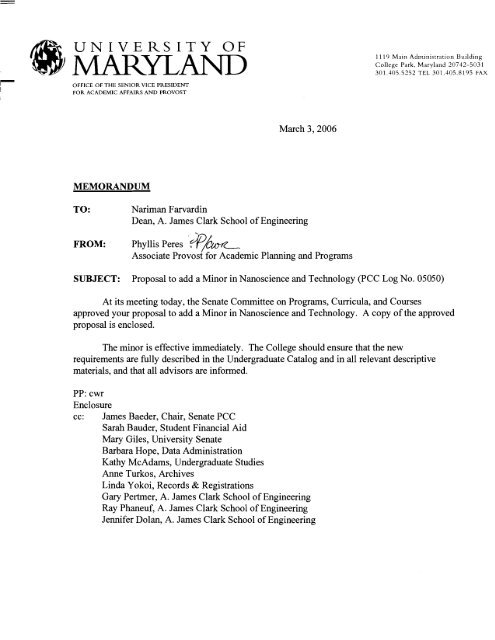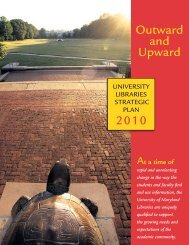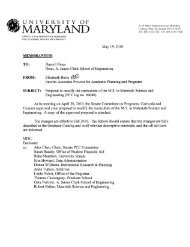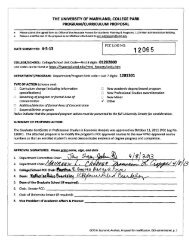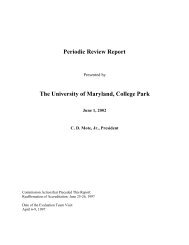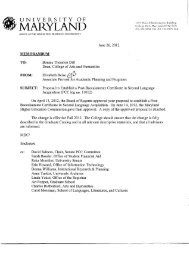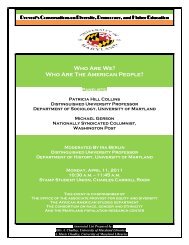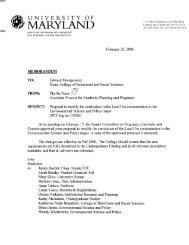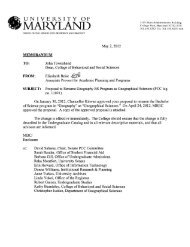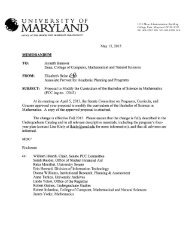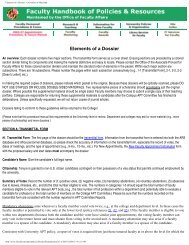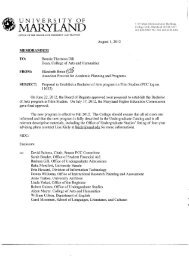05050 ENGR ENMA Add Minor in Nanoscience and Technology
05050 ENGR ENMA Add Minor in Nanoscience and Technology
05050 ENGR ENMA Add Minor in Nanoscience and Technology
Create successful ePaper yourself
Turn your PDF publications into a flip-book with our unique Google optimized e-Paper software.
UNIVERSITY OF<br />
NLAPV'AND I OFFICE OF THE SENIOR VICE PRESIDENT<br />
! FOR ACADEMIC AFFAIRS AND PROVOST<br />
MEMORANDUM<br />
March 3,2006<br />
TO: Nariman Farvard<strong>in</strong><br />
'"*/%<br />
Dean, A. James Clark School of Eng<strong>in</strong>eer<strong>in</strong>g<br />
FROM: Phyllis Peres<br />
Associate Provost for Academic Plann<strong>in</strong>g <strong>and</strong> Programs<br />
11 19 Ma<strong>in</strong> Ad<strong>in</strong><strong>in</strong>istration Build<strong>in</strong>g<br />
College Park. Maryl<strong>and</strong> 20742-5031<br />
301.405.5252 TEL 301.405.8195 FAX<br />
SUBJECT: Proposal to add a <strong>M<strong>in</strong>or</strong> <strong>in</strong> <strong>Nanoscience</strong> <strong>and</strong> <strong>Technology</strong> (PCC Log No. <strong>05050</strong>)<br />
At its meet<strong>in</strong>g today, the Senate Committee on Programs, Curricula, <strong>and</strong> Courses<br />
approved your proposal to add a <strong>M<strong>in</strong>or</strong> <strong>in</strong> <strong>Nanoscience</strong> <strong>and</strong> <strong>Technology</strong>. A copy of the approved<br />
proposal is enclosed.<br />
The m<strong>in</strong>or is effective immediately. The College should ensure that the new<br />
requirements are fully described <strong>in</strong> the Undergraduate Catalog <strong>and</strong> <strong>in</strong> all relevant descriptive<br />
materials. <strong>and</strong> that all advisors are <strong>in</strong>formed.<br />
PP: cwr<br />
Enclosure<br />
cc: James Baeder, Chair, Senate PCC<br />
Sarah Bauder, Student F<strong>in</strong>ancial Aid<br />
Mary Giles, University Senate<br />
Barbara Hope, Data Adm<strong>in</strong>istration<br />
Kathy McAdams, Undergraduate Studies<br />
Anne Turkos, Archives<br />
L<strong>in</strong>da Yokoi, Records & Registrations<br />
Gary Pertmer, A. James Clark School of Eng<strong>in</strong>eer<strong>in</strong>g<br />
Ray Phaneuf, A. James Clark School of Eng<strong>in</strong>eer<strong>in</strong>g<br />
Jennifer Dolan, A. James Clark School of Eng<strong>in</strong>eer<strong>in</strong>g
- ~-<br />
THE UNIVERSITY OF MARYLAND, COLLEGE PARK<br />
PROGRAMICURRICULUM PROPOSAL<br />
DIRECTIONS:<br />
Provide one form with orig<strong>in</strong>al approval signatures <strong>in</strong> l<strong>in</strong>es 1 - 4 for each proposed action. Keep this form to one page <strong>in</strong> length.<br />
= Early consultation with the Office of the Associate Provost for Academic Plann<strong>in</strong>g & Programs is strongly recommended if there are<br />
questions or concerns, particularly with new programs.<br />
Please submit the signed form to Claudia Rector, Office of the Associate Provost for Academic Plann<strong>in</strong>g <strong>and</strong> Programs, 11 19 Ma<strong>in</strong><br />
Adm<strong>in</strong>istration Build<strong>in</strong>g, Campus.<br />
Please email the rest of the proposal as an MSWord attachment to pcc-submissionsiic,umd.edu.<br />
DATE SUBMITTED-8129105-<br />
COLLEGEISCHOOL-Clark School of Eng<strong>in</strong>eer<strong>in</strong>g-<br />
PCC LOG NO.<br />
<strong>05050</strong><br />
DEPARTMENTIPROGRAM-Interdiscipl<strong>in</strong>ary, centered <strong>in</strong> Materials Science <strong>and</strong> Eng<strong>in</strong>eeer-<br />
PROPOSED ACTION (A separate,formfor each) ADD-X- DELETE CHANGE<br />
DESCRIPTION (Provide a succ<strong>in</strong>ct account of the proposed action. Details should be provided <strong>in</strong> an<br />
attachment. Provide old <strong>and</strong> new sample programs for curricult~m changes.)<br />
Establish an Interdiscipl<strong>in</strong>ary <strong>M<strong>in</strong>or</strong> program <strong>in</strong> <strong>Nanoscience</strong> <strong>and</strong> <strong>Technology</strong> with<strong>in</strong> Materials Science <strong>and</strong><br />
Eng<strong>in</strong>eer<strong>in</strong>g, Chemical Eng<strong>in</strong>eer<strong>in</strong>g, Electrical <strong>and</strong> Computer Eng<strong>in</strong>eer<strong>in</strong>g, Mechanical Eng<strong>in</strong>eer<strong>in</strong>g, Physics<br />
<strong>and</strong> Chemistry. (See attached for details).<br />
JUSTIFICATIONIREASONSIRESOURCES (Briejlv expla<strong>in</strong> the reason for the proposed action. Identgv the<br />
source of new resources that may be required. Details should be provided <strong>in</strong> an attachment.)<br />
There is at present explosive growth <strong>in</strong> the field of nanometer scale science <strong>and</strong> technology (NS&T), which has <strong>in</strong> the past few years<br />
led to many technological advances <strong>in</strong> devices <strong>and</strong> materials structured at the nanometer scale. Anticipat<strong>in</strong>g cont<strong>in</strong>ued growth <strong>in</strong> this<br />
area <strong>and</strong> the need for scientists <strong>and</strong> eng<strong>in</strong>eers who are tra<strong>in</strong>ed <strong>in</strong> NS&T we propose to establish an <strong>in</strong>terdiscipl<strong>in</strong>aryprogram of study<br />
<strong>in</strong> nanoscience <strong>and</strong>technology at the University of Maryl<strong>and</strong>. We believe that this m<strong>in</strong>or will help to prepare participat<strong>in</strong>g<br />
University of Maryl<strong>and</strong> students for a career <strong>in</strong> this rapidly develop<strong>in</strong>g field. We envision that this program will draw upon the<br />
considerable exist<strong>in</strong>g level of expertise <strong>in</strong> nanoscience at Maryl<strong>and</strong>, as well as that of the new faculty presently be<strong>in</strong>g recruited <strong>in</strong> a<br />
number of departments. We further propose that participat<strong>in</strong>g departments will use exist<strong>in</strong>g courses as electives for the NS&T m<strong>in</strong>or.<br />
At least <strong>in</strong>itially, based upon an estimated total participation of 30-50 students, we expect there should be no additional resources or<br />
APPROVAL SlGNATURE<br />
I. Department Committee Chair<br />
2. Department Chair<br />
3. Colleg<br />
4. Dean<br />
5. Dean of the Graduate School (if required)<br />
6. Chair, Senate PCC 3 13 /o&<br />
7. Chair of Senate<br />
8. Vice President for Academic Affairs & Provost<br />
V<br />
A<br />
3 13/06
Proposal to Create an Interdiscipl<strong>in</strong>ary <strong>M<strong>in</strong>or</strong> Program of Undergraduate Study <strong>in</strong><br />
Nanoscale Science <strong>and</strong> <strong>Technology</strong><br />
Prepared by:<br />
Ray Phaneuf, Materials Science <strong>and</strong> Eng<strong>in</strong>eer<strong>in</strong>g<br />
With contributions from<br />
Ichiro Takeuchi, Materials Science <strong>and</strong> Eng<strong>in</strong>eer<strong>in</strong>g<br />
Sheryl Ehrman, Chemical & Biomolecular Eng<strong>in</strong>eer<strong>in</strong>g<br />
Sr<strong>in</strong>i Raghavan, Chemical & Biomolecular Eng<strong>in</strong>eer<strong>in</strong>g<br />
Michael Zachariah, Mechanical Eng<strong>in</strong>eer<strong>in</strong>g<br />
John Melngailis, Electrical <strong>and</strong> Computer Eng<strong>in</strong>eer<strong>in</strong>g<br />
Michael Fuhrer, Physics<br />
Sang Bok Lee, Chemistry & Biochemistry<br />
Gary Rubloff, M-CINSE, ISR & MSE<br />
Updated November 17, 2005<br />
There is at present explosive growth <strong>in</strong> the field of nanometer scale science <strong>and</strong><br />
technology (NS&T), which has <strong>in</strong> the past few years led to many technological advances<br />
<strong>in</strong> devices <strong>and</strong> materials structured at the nanometer scale. Anticipat<strong>in</strong>g cont<strong>in</strong>ued<br />
growth <strong>in</strong> this area <strong>and</strong> the need for scientists <strong>and</strong> eng<strong>in</strong>eers who are tra<strong>in</strong>ed <strong>in</strong> NS&T we<br />
propose to establish an <strong>in</strong>terdiscipl<strong>in</strong>ary program of study <strong>in</strong> nanoscience <strong>and</strong><br />
technology at the University of Maryl<strong>and</strong>. We believe that this m<strong>in</strong>or will help to<br />
prepare participat<strong>in</strong>g University of Maryl<strong>and</strong> students for a career <strong>in</strong> this rapidly<br />
develop<strong>in</strong>g field. We envision that this program will draw upon the considerable exist<strong>in</strong>g<br />
level of expertise <strong>in</strong> nanoscience at Maryl<strong>and</strong>, as well as that of the new faculty presently<br />
be<strong>in</strong>g recruited <strong>in</strong> a number of departments. Below we describe the proposed<br />
organization, exist<strong>in</strong>g courses, <strong>and</strong> model programs for participat<strong>in</strong>g students.<br />
Requirements, Participation <strong>and</strong> Adm<strong>in</strong>istration of the <strong>M<strong>in</strong>or</strong><br />
The Faculty Senate has set forth specific requirements for m<strong>in</strong>or programs. In<br />
particular, “A m<strong>in</strong>or should have no fewer than 15 <strong>and</strong> no more than 24 academic credits,<br />
with at least n<strong>in</strong>e credits at the upper level. A unit may apply for an exception to these<br />
criteria. Such application may particularly apply <strong>in</strong> situations where there are "hidden<br />
prerequisites" <strong>and</strong>/or <strong>in</strong> situations <strong>in</strong> which students have taken the prerequisites to the<br />
m<strong>in</strong>or as part of another degree program.” In addition “A student may use a maximum of<br />
six credits (or two courses) to satisfy the requirements of both a major <strong>and</strong> a m<strong>in</strong>or. A<br />
unit may place additional limits on the allowed overlap. Courses completed <strong>in</strong> one m<strong>in</strong>or<br />
may not be used to satisfy the requirements <strong>in</strong> another m<strong>in</strong>or.” The relatively large<br />
number of exist<strong>in</strong>g courses, <strong>and</strong> anticipated courses listed would allow these<br />
requirements to be met. The latter requirement would mean that the curricula will vary<br />
somewhat, department by department.
Participation by a Department <strong>in</strong>volves:<br />
(1) Designat<strong>in</strong>g at least one faculty coord<strong>in</strong>ator who will<br />
(a) work with students from that Department to develop a program <strong>and</strong><br />
schedule of courses at the time they declare participation <strong>in</strong> the NS&T<br />
m<strong>in</strong>or,<br />
(b) meet once a year with those students to provide advis<strong>in</strong>g <strong>and</strong><br />
(c) provide assessment data to the NS&T m<strong>in</strong>or committee,<br />
(2) Designat<strong>in</strong>g a faculty member of the NS&T committee, which will make<br />
decisions <strong>in</strong> modify<strong>in</strong>g curriculum, <strong>and</strong> establish<strong>in</strong>g procedures, <strong>and</strong><br />
(3) Offer<strong>in</strong>g courses which serve as part of the NS&T m<strong>in</strong>or; agree<strong>in</strong>g to accept<br />
nonmajors <strong>in</strong>to those courses <strong>and</strong> to give careful consideration to relaxation of<br />
prerequisites to declared NS&T m<strong>in</strong>or students.<br />
The follow<strong>in</strong>g departments have agreed to participate <strong>in</strong> the Interdiscipl<strong>in</strong>ary<br />
NS&T <strong>M<strong>in</strong>or</strong>: Materials Science <strong>and</strong> Eng<strong>in</strong>eer<strong>in</strong>g, Electrical <strong>and</strong> Computer<br />
Eng<strong>in</strong>eer<strong>in</strong>g, Mechanical Eng<strong>in</strong>eer<strong>in</strong>g, Chemistry & Biochemistry <strong>and</strong> Physics.<br />
The adm<strong>in</strong>istration of the NS&T will be carried out by Faculty from each of the<br />
participat<strong>in</strong>g departments; a committee of these faculty members will design the<br />
curricula, <strong>in</strong> accordance with the Faculty Senate’s requirements which were<br />
established on February 9, 2004, <strong>and</strong> are stated below.<br />
As there needs to be a contact po<strong>in</strong>t where students <strong>and</strong> faculty from outside of<br />
the participat<strong>in</strong>g departments can go for <strong>in</strong>formation <strong>and</strong> advis<strong>in</strong>g, we also<br />
propose that, <strong>in</strong> coord<strong>in</strong>ation with the new Maryl<strong>and</strong> Center for Integrated<br />
NanoScience <strong>and</strong> Eng<strong>in</strong>eer<strong>in</strong>g (MCINSE), the Department of Materials Science<br />
<strong>and</strong> Eng<strong>in</strong>eer<strong>in</strong>g (MSE) will act as the sponsor<strong>in</strong>g <strong>and</strong> central adm<strong>in</strong>ister<strong>in</strong>g unit.<br />
This is <strong>in</strong> part because of the relatively large fraction of MSE faculty <strong>in</strong>volved <strong>in</strong><br />
nanoscale science <strong>and</strong> technology research, <strong>and</strong> <strong>in</strong> part because of the<br />
multidiscipl<strong>in</strong>ary nature of the department.<br />
Each participat<strong>in</strong>g department will supply an <strong>in</strong>dividual faculty coord<strong>in</strong>ator for<br />
that department, with Prof. Ray Phaneuf act<strong>in</strong>g as the overall faculty coord<strong>in</strong>ator<br />
for the m<strong>in</strong>or. Faculty coord<strong>in</strong>ators will design <strong>in</strong>dividual student programs, <strong>and</strong><br />
oversee the progress of students from their department toward satisfy<strong>in</strong>g the<br />
m<strong>in</strong>or. Faculty members who have agreed to serve as departmental NS&T m<strong>in</strong>or<br />
coord<strong>in</strong>ators are:<br />
Ray Phaneuf, Materials Science <strong>and</strong> Eng<strong>in</strong>eer<strong>in</strong>g<br />
Michael Fuhrer, Physics<br />
Sang Bok Lee, Chemistry & Biochemistry<br />
Bao Yang, Mechanical Eng<strong>in</strong>eer<strong>in</strong>g<br />
John Melngailis, Electrical <strong>and</strong> Computer Eng<strong>in</strong>eer<strong>in</strong>g
Sr<strong>in</strong>i Raghavan, Chemical <strong>and</strong> Biomolecular Eng<strong>in</strong>eer<strong>in</strong>g<br />
In addition the follow<strong>in</strong>g faculty will serve on the NS&T committee<br />
Ray Phaneuf, Materials Science <strong>and</strong> Eng<strong>in</strong>eer<strong>in</strong>g<br />
Michael Fuhrer, Physics<br />
Sang Bok Lee, Chemistry & Biochemistry<br />
Sheryl Ehrman, Chemical <strong>and</strong> Biomolecular Eng<strong>in</strong>eer<strong>in</strong>g<br />
John Melngailis, Electrical <strong>and</strong> Computer Eng<strong>in</strong>eer<strong>in</strong>g<br />
Michael Zachariah, Mechanical Eng<strong>in</strong>eer<strong>in</strong>g<br />
Gary Rubloff, M-CINSE, MSE & ISR<br />
Sr<strong>in</strong>i Raghavan, Chemical <strong>and</strong> Biomolecular Eng<strong>in</strong>eer<strong>in</strong>g<br />
Advis<strong>in</strong>g <strong>and</strong> Assessment<br />
Advis<strong>in</strong>g of participat<strong>in</strong>g students will beg<strong>in</strong> with the development of the<br />
<strong>in</strong>dividual program of courses at the time a student declares participation <strong>in</strong> the NS&T<br />
m<strong>in</strong>or, <strong>and</strong> will cont<strong>in</strong>ue with a yearly meet<strong>in</strong>g until the requirements for the m<strong>in</strong>or are<br />
satisfied. Students will be required to obta<strong>in</strong> the signature of their faculty coord<strong>in</strong>ator to<br />
document that the advis<strong>in</strong>g sessions take place.<br />
Assessment of the NS&T m<strong>in</strong>or will be based upon the success that participat<strong>in</strong>g<br />
students have <strong>in</strong> achiev<strong>in</strong>g the follow<strong>in</strong>g learn<strong>in</strong>g outcomes:<br />
1. Student demonstrates an underst<strong>and</strong><strong>in</strong>g of the background concepts that underlie<br />
science at the nanometer scale.<br />
2. Student demonstrates <strong>and</strong> underst<strong>and</strong><strong>in</strong>g or ability to carry out techniques for<br />
fabrication <strong>and</strong> or synthesis of nanostructures or materials structured at the nanometer<br />
scale.<br />
3. Student demonstrates an underst<strong>and</strong><strong>in</strong>g or ability to carry out techniques for<br />
characteriz<strong>in</strong>g the properties, function <strong>and</strong> performance of nanostructures.<br />
4. Student demonstrates an underst<strong>and</strong><strong>in</strong>g of applications of nanotechnology to<br />
comput<strong>in</strong>g, data storage, sens<strong>in</strong>g, biology or other fields relevant to <strong>in</strong>dustry <strong>and</strong>/or<br />
society.<br />
The assessment will be based upon performance on the Midterm <strong>and</strong> F<strong>in</strong>al exam<strong>in</strong>ation<br />
for each course credited toward the m<strong>in</strong>or, Participat<strong>in</strong>g students will be required to<br />
provide copies of these exams to allow assessment of their performance on those areas<br />
listed above (i.e. 1-4 above) which are relevant to that course; this will be decided by the<br />
NS&T committee, <strong>in</strong> consultation with the <strong>in</strong>structor. The departmental coord<strong>in</strong>ator will<br />
be asked to assign scores on a scale of 1-4 for each student based upon answers to<br />
questions dur<strong>in</strong>g the annual advis<strong>in</strong>g section. The grad<strong>in</strong>g scale is as follows:
1. Student shows no underst<strong>and</strong><strong>in</strong>g of/skills toward this major goal for the course.<br />
2. Student shows little underst<strong>and</strong><strong>in</strong>g of/skills toward this major goal for the course.<br />
3. Student shows moderate underst<strong>and</strong><strong>in</strong>g of/skills toward this major goal for the<br />
course.<br />
4. Student demonstrates to have mastered this major goal for the course.<br />
For each course, the departmental coord<strong>in</strong>ator will provide the <strong>in</strong>dividual scores on each<br />
outcome for participat<strong>in</strong>g students to the NS&T adm<strong>in</strong>istrator, Kathleen Hart. An<br />
average will be calculated for each student on all outcomes for a given course <strong>and</strong> an<br />
overall course average for all students <strong>in</strong> each course. This process will allow for<br />
detailed quantitative track<strong>in</strong>g of the NS&T educational program, <strong>and</strong> will be used <strong>in</strong><br />
mak<strong>in</strong>g changes to the overall NS&T curriculum, f<strong>in</strong>e-tun<strong>in</strong>g the outcomes for <strong>in</strong>dividual<br />
courses <strong>and</strong> addition of new courses. The results for specific courses will also be used <strong>in</strong><br />
provid<strong>in</strong>g feedback to <strong>in</strong>structors of particular courses.<br />
Resources: Exist<strong>in</strong>g Courses <strong>and</strong> Anticipated Courses<br />
We propose that participat<strong>in</strong>g departments will use exist<strong>in</strong>g courses as electives<br />
for the NS&T m<strong>in</strong>or. At least <strong>in</strong>itially, based upon an estimated total participation of<br />
30-50 students, we expect there should be no additional resources or costs associated<br />
with participation. Participat<strong>in</strong>g departments have agreed to accept non majors <strong>in</strong>to<br />
those courses which they designate as part of the NS&T m<strong>in</strong>or; letters from department<br />
chairs are <strong>in</strong>cluded with this proposal. To avoid oversubscription of popular courses,<br />
each departmental representative to the NS&T m<strong>in</strong>or program will work with students<br />
from that department to develop a program of study, coord<strong>in</strong>ated with the central<br />
adm<strong>in</strong>istration for the m<strong>in</strong>or, at the time that a student declares participation. Initially,<br />
the total number of students might be capped at a level consistent with the available seats<br />
<strong>in</strong> exist<strong>in</strong>g courses, with each department allotted a number of participants. Alternatively,<br />
if the program proves extremely popular <strong>and</strong> participat<strong>in</strong>g departments agree, the cap<br />
might be lifted <strong>and</strong> additional costs distributed among participat<strong>in</strong>g departments.<br />
A number of courses specifically on nanoscience/nanotechnology have already been<br />
developed at the undergraduate level at the University of Maryl<strong>and</strong>, <strong>and</strong> are currently<br />
be<strong>in</strong>g offered. Follow<strong>in</strong>g is a table of courses distributed among 6 departments which<br />
we propose to <strong>in</strong>clude <strong>in</strong> the NS&T m<strong>in</strong>or:<br />
Course Department Instructor Approach<br />
<strong>ENMA</strong>489T Materials Science & Ray NanoCharacterization<br />
Nanocharacterization Eng<strong>in</strong>eer<strong>in</strong>g<br />
Phaneuf<br />
<strong>ENMA</strong>489M<br />
Diffraction<br />
Techniques<br />
CHEM425<br />
Instrumental Methods<br />
Materials Science &<br />
Eng<strong>in</strong>eer<strong>in</strong>g<br />
Chemistry &<br />
Biochemistry<br />
Luz Nanocharacterization<br />
Mart<strong>in</strong>ez-<br />
Mir<strong>and</strong>a<br />
Neil Blough NanoCharacterization
of Analysis<br />
BCHM464<br />
Biochemistry Lab I<br />
XXXX499 Research<br />
Experience (if NS&T<br />
related)<br />
ENEE 416 Integrated<br />
Circuit Fabrication<br />
Lab<br />
<strong>ENMA</strong>465<br />
Microprocess<strong>in</strong>g<br />
ENCH 471 Particle<br />
Science And<br />
<strong>Technology</strong><br />
ENME489F Micro-<br />
Electro-Mechanical<br />
Systems<br />
ENCH496/<strong>ENMA</strong>496<br />
Polymer Process<strong>in</strong>g<br />
<strong>and</strong> Eng<strong>in</strong>eer<strong>in</strong>g<br />
ENEE312<br />
Semiconductor<br />
Devices <strong>and</strong> Analog<br />
Circuits<br />
Capstone Design<br />
(if NS&T related)<br />
ENCH490/<strong>ENMA</strong>495<br />
Polymers,<br />
Biopolymers <strong>and</strong> their<br />
Applications <strong>in</strong> Nano<strong>and</strong><br />
Bio- technology<br />
BCHM461<br />
Biochemistry I<br />
<strong>ENMA</strong>481<br />
Electronic <strong>and</strong><br />
Optical Materials<br />
Chemistry &<br />
Biochemistry<br />
Soheila<br />
Ebrahimian<br />
Participat<strong>in</strong>g Department Research<br />
Advisor<br />
Electrical <strong>and</strong> Computer<br />
Eng<strong>in</strong>eer<strong>in</strong>g<br />
Materials Science &<br />
Eng<strong>in</strong>eer<strong>in</strong>g<br />
Chemical &<br />
BiomolecularEng<strong>in</strong>eer<strong>in</strong>g<br />
John<br />
Melngailis<br />
Gary<br />
Rubloff<br />
Sheryl<br />
Ehrman<br />
Mechanical Eng<strong>in</strong>eer<strong>in</strong>g Elisabeth.<br />
Smela<br />
Chemical &<br />
Biomolecular<br />
Eng<strong>in</strong>eer<strong>in</strong>g /<br />
Materials Science &<br />
Eng<strong>in</strong>eer<strong>in</strong>g<br />
Electrical <strong>and</strong> Computer<br />
Eng<strong>in</strong>eer<strong>in</strong>g<br />
Peter<br />
Kof<strong>in</strong>as/<br />
Richard<br />
Calabrese<br />
Timothy<br />
Horiuchi<br />
Nanocharacterization<br />
Characterization/<br />
Fabrication/Synthesis<br />
NanoApplication /<br />
Specialization<br />
NanoFabrication/Synthesis<br />
NanoFabrication/Synthesis<br />
NanoFabrication/Synthesis<br />
NanoApplication /<br />
Specialization<br />
NanoFabrication/Synthesis<br />
NanoApplication /<br />
Specialization<br />
NanoFabrication/Synthesis<br />
NanoApplication /<br />
Specialization<br />
NanoApplication /<br />
Specialization (To be<br />
credited only if taken as a<br />
prerequisite to ENEE416<br />
or ENEE480)<br />
Major Department varies NanoApplication /<br />
Specialization<br />
Chemical &<br />
Peter NanoApplication/<br />
Biomolecular<br />
Kof<strong>in</strong>as/ Specialization/<br />
Eng<strong>in</strong>eer<strong>in</strong>g /<br />
Kyu Yong Fundamental Science<br />
Materials Science &<br />
Eng<strong>in</strong>eer<strong>in</strong>g<br />
Choi<br />
Chemistry &<br />
Biochemistry<br />
Materials Science &<br />
Eng<strong>in</strong>eer<strong>in</strong>g/Physics<br />
Soheila<br />
Ebrahimian<br />
Ichiro<br />
Takeuchi<br />
NanoApplication /<br />
Specialization<br />
Fundamental Science<br />
NanoApplication /<br />
Specialization<br />
Fundamental Science
<strong>ENMA</strong>460/PHYS431<br />
Solid State Physics<br />
ENCH 470: Soft<br />
Nanotechnologies<br />
ENCH 468Q<br />
Mesoscopic <strong>and</strong><br />
Nanoscale<br />
Thermodynamics<br />
ENEE 480<br />
Fundamentals of<br />
Solid State<br />
Electronics<br />
ENEE489Q Quantum<br />
Effects <strong>in</strong> Electrical<br />
Eng<strong>in</strong>eer<strong>in</strong>g<br />
PHYS401 Quantum<br />
Physics I<br />
PHYS404 Thermal &<br />
Statistical Physics<br />
PHYS420 Modern<br />
Materials Science &<br />
Eng<strong>in</strong>eer<strong>in</strong>g/Physics<br />
Chemical &<br />
Biomolecular<br />
Eng<strong>in</strong>eer<strong>in</strong>g<br />
Chemical &<br />
Biomolecular<br />
Eng<strong>in</strong>eer<strong>in</strong>g<br />
Electrical <strong>and</strong> Computer<br />
Eng<strong>in</strong>eer<strong>in</strong>g<br />
Electrical <strong>and</strong> Computer<br />
Eng<strong>in</strong>eer<strong>in</strong>g<br />
Ichiro<br />
Takeuchi<br />
Sr<strong>in</strong>i<br />
Raghavan<br />
Mikhail<br />
Anisimov<br />
Fundamental Science<br />
Fundamental Science<br />
Fundamental Science<br />
Jon Orloff Fundamental Science<br />
Romel<br />
Gomez<br />
Fundamental Science<br />
Physics Thomas<br />
Cohen<br />
Fundamental Science<br />
Physics Chris Lobb Fundamental Science<br />
Physics Bei-Lok. Fundamental Science<br />
Physics<br />
Hu<br />
CHEM481 Physical Chemistry &<br />
Janice Fundamental Science<br />
Chemistry I<br />
Biochemistry<br />
Reutt-<br />
Robey<br />
CHEM482 Physical Chemistry &<br />
Millard Fundamental Science<br />
Chemistry II<br />
Biochemistry<br />
Alex<strong>and</strong>er<br />
BCHM485 Physical Chemistry &<br />
Fushman Fundamental Science<br />
Biochemistry Biochemistry<br />
Table 1. Exist<strong>in</strong>g courses which may be credited toward the NS&T m<strong>in</strong>or.<br />
We anticipate that additional courses will be added as new NS&T faculty hires<br />
are made. An example is “The Physics <strong>and</strong> Chemistry of Nanostructures”, which is be<strong>in</strong>g<br />
developed by M<strong>in</strong> Ouyang, a new Assistant Professor <strong>in</strong> Physics, <strong>and</strong> which is described<br />
<strong>in</strong> the <strong>Add</strong>enda. New lab-based courses are also anticipated based upon the open<strong>in</strong>g of<br />
new facilities such as. the teach<strong>in</strong>g lab <strong>in</strong> the Kim Build<strong>in</strong>g. As new courses are<br />
developed the NS&T committee will meet <strong>and</strong> decide upon add<strong>in</strong>g them to the list.<br />
Eligibility <strong>and</strong> Structure of the Proposed NS&T <strong>M<strong>in</strong>or</strong><br />
Eligibility
This m<strong>in</strong>or is designed to be accessible <strong>and</strong> available to any student major<strong>in</strong>g <strong>in</strong><br />
Eng<strong>in</strong>eer<strong>in</strong>g, Physics or Chemistry & Biochemistry. It is open to all students who have<br />
the necessary prerequisites to enroll <strong>in</strong> the courses which constitute the m<strong>in</strong>or.<br />
Structure of NS&T <strong>M<strong>in</strong>or</strong><br />
<strong>Nanoscience</strong> <strong>and</strong> <strong>Technology</strong> is a broad field, with a number of different major<br />
directions; partial list would <strong>in</strong>clude fabrication of extremely densely <strong>in</strong>tegrated logic or<br />
storage elements for comput<strong>in</strong>g, development of nanomaterials for catalysis or sens<strong>in</strong>g<br />
applications, soft nanotechnology, <strong>and</strong> bio/nanotechnology. To allow for different areas<br />
of <strong>in</strong>terest we have <strong>in</strong>cluded a number of courses with overlapp<strong>in</strong>g subjects but different<br />
emphasis. To meet the University’s requirement that m<strong>in</strong>ors be structured to provide<br />
students with a coherent field of study <strong>and</strong> a carefully considered <strong>in</strong>tellectual justification,<br />
rather than a r<strong>and</strong>om choice of courses from current offer<strong>in</strong>gs <strong>in</strong> a major we have<br />
assembled model programs. These will provide the necessary coherence <strong>and</strong> <strong>in</strong>tellectual<br />
merit, while reflect<strong>in</strong>g <strong>in</strong>dividual directions <strong>in</strong> NS&T. We see the <strong>in</strong>terdiscipl<strong>in</strong>ary<br />
nature of these programs as crucial to the <strong>in</strong>tellectual merit of the NS&T m<strong>in</strong>or; by tak<strong>in</strong>g<br />
courses <strong>in</strong> a number of departments, the student ga<strong>in</strong>s a broader view of this field. We<br />
describe model programs <strong>in</strong> the last section of this proposal.<br />
The programs of study will be constructed so as to avoid duplication of material,<br />
e.g, a student tak<strong>in</strong>g Quantum Physics (PHYS401) will not also receive credit toward the<br />
NS&T m<strong>in</strong>or for Modern Physics (PHYS420) or Quantum Mechanics (ENEE489Q). We<br />
have also settled upon four overall approaches as describ<strong>in</strong>g most of what goes on <strong>in</strong><br />
<strong>Nanoscience</strong> & <strong>Technology</strong>: (1) Fabrication <strong>and</strong> Synthesis of nanostructures, i.e. how<br />
they are made (2) Characterization of nanostructures, <strong>in</strong>clud<strong>in</strong>g how the properties <strong>and</strong><br />
function of nanostructures (e.g. transport) are measured or determ<strong>in</strong>ed (3) Fundamental<br />
science which serves as a basis for NS&T <strong>and</strong> (4) Application areas of NS&T.
Figure 1. Coord<strong>in</strong>ate axes represent<strong>in</strong>g ranges of approach <strong>in</strong> NanoScience &<br />
<strong>Technology</strong>.<br />
NS&T can be regarded as spanned by two orthogonal axes, represented<br />
graphically <strong>in</strong> Figure 1. Fabrication/Synthesis <strong>and</strong> Characterization emphasize<br />
experimental efforts, while Fundamental Science <strong>and</strong> Specialization Electives emphasize<br />
the underly<strong>in</strong>g pr<strong>in</strong>ciples <strong>and</strong> directions, <strong>and</strong> <strong>in</strong>clude underly<strong>in</strong>g theory <strong>and</strong> the<br />
motivations for NS&T. We believe that it is essential that a student with a m<strong>in</strong>or <strong>in</strong><br />
NS&T must have a background <strong>in</strong> the underly<strong>in</strong>g fundamental science, e.g., it is not<br />
possible to underst<strong>and</strong> why conf<strong>in</strong>ement effects occur without hav<strong>in</strong>g studied quantum<br />
mechanics. Similarly, <strong>in</strong> soft nanotechnology a student must have studied statistical<br />
mechanics to underst<strong>and</strong> the entropic <strong>in</strong>teractions which govern polymer fold<strong>in</strong>g <strong>and</strong><br />
pack<strong>in</strong>g. In Table 1, we have listed the major approach taken by each of the courses we<br />
propose to <strong>in</strong>clude. Several of the courses span two or more categories, <strong>and</strong> might be<br />
counted <strong>in</strong> either, especially given that more than one <strong>in</strong>structor teaches the course. An<br />
important function of the faculty coord<strong>in</strong>ator from each department will be to ascerta<strong>in</strong><br />
from the <strong>in</strong>structor which classification is more suitable, based upon communication with<br />
the <strong>in</strong>structor teach<strong>in</strong>g the course that semester. There are not clear divisions between<br />
Fundamental Science <strong>and</strong> Specialization areas; similarly courses deal<strong>in</strong>g with fabrication<br />
will usually also require some characterization. Thus as a way of build<strong>in</strong>g structure <strong>and</strong><br />
sufficient breadth <strong>in</strong>to the programs of study we will encourage students to take courses<br />
from each of the four areas as an ideal, but require that students take at least two courses<br />
each from the Fundamental Science-Specialization axis, <strong>and</strong> at least two from the<br />
Fabrication-Characterization axis depicted <strong>in</strong> Fig. 1, <strong>and</strong> listed <strong>in</strong> Table 2. Def<strong>in</strong>ition of<br />
which courses satisfy which requirements will be established by the NS&T committee.
To further encourage breadth of study, the NS&T m<strong>in</strong>or will allow only two of the five<br />
total courses to be from a student’s major department.<br />
1. The m<strong>in</strong>or requirement will consist of a total of five courses (at least 15 credits) from<br />
those listed below. (see Table 1, below).<br />
2. At least two of the courses (6 credits) must be from the list of<br />
Nanofabrication/Nanosynthesis <strong>and</strong>/or Nanocharacterization electives.<br />
3. At least two of the courses (6 credits) must be from the list of Fundamental Science<br />
<strong>and</strong>/or <strong>Nanoscience</strong> Electives. At least one of these must be listed as a<br />
Nanospecialization/application elective.<br />
4. Up to two courses (6 credits) may be double counted, i.e. used both toward satisfy<strong>in</strong>g<br />
the requirements of the major <strong>and</strong> the NS&T m<strong>in</strong>or.<br />
5. Three of the courses (9 credits) must be from outside the <strong>in</strong>dividual major. Cross<br />
listed courses (e.g. <strong>ENMA</strong>460/PHYS431) which are offered by the major department do<br />
not qualify as be<strong>in</strong>g outside the major.<br />
6. At least three of the courses (9 credits) must be at the 400 level or above.<br />
7. No more than two courses (6 credits) from any one department will be credited toward<br />
the NS&T m<strong>in</strong>or.<br />
8. A grade of “C” or above is required <strong>in</strong> all courses to be credited toward the NS&T<br />
m<strong>in</strong>or.<br />
9. Students wish<strong>in</strong>g to participate <strong>in</strong> the NS&T m<strong>in</strong>or must declare participation formally.<br />
Declaration of participation <strong>in</strong> the NS&T m<strong>in</strong>or must follow a meet<strong>in</strong>g with the<br />
<strong>in</strong>dividual department representative to the NS&T committee who will help the student to<br />
develop a program of courses suitable for the m<strong>in</strong>or <strong>and</strong> a schedule for tak<strong>in</strong>g those<br />
courses. Examples of model programs for each participat<strong>in</strong>g department are given below.<br />
Students from outside participat<strong>in</strong>g departments will consult with one of the MSE<br />
representatives to develop a program of courses <strong>and</strong> declare participation..<br />
10.. Research experience(XXXX499) courses may be <strong>in</strong>cluded <strong>in</strong> the NS&T m<strong>in</strong>or <strong>in</strong><br />
addition to those listed above, provided that the research is NS&T-related. The course<br />
must be with<strong>in</strong> a participat<strong>in</strong>g department. Similarly, if the design capstone course (e.g.<br />
<strong>ENMA</strong>490) from a department is judged to be <strong>in</strong> the area of NS&T, it may be counted as<br />
a Specialization Elective toward the m<strong>in</strong>or. Judgment of whether these courses qualify<br />
will fall to the departmental Nano-Program Committee member.<br />
Model Programs
First <strong>and</strong> foremost, each program of study should have sufficient breadth to allow<br />
the student flexibility <strong>in</strong> learn<strong>in</strong>g about this multidiscipl<strong>in</strong>ary field. Simultaneously, they<br />
should <strong>in</strong>still the basic underly<strong>in</strong>g scientific pr<strong>in</strong>ciples necessary for <strong>in</strong>tellectual<br />
achievement, <strong>and</strong> for underst<strong>and</strong><strong>in</strong>g the technological possibilities <strong>and</strong> limitations of<br />
NS&T. As nanoscale science <strong>and</strong> technology is to a large degree experimentally driven,<br />
lecture courses should be supplemented by courses on fabrication/synthesis <strong>and</strong><br />
characterization. Furthermore, the fast pace of development <strong>in</strong> this field makes it nearly<br />
impossible to develop up to date textbooks. We expect that some of the courses will<br />
supplement a traditional lecture approach, with guest sem<strong>in</strong>ars, <strong>in</strong> which scientists <strong>and</strong><br />
senior students speak about ongo<strong>in</strong>g research <strong>in</strong> this field. <strong>ENMA</strong>489T, Nanotechnology<br />
Characterization, has already successfully adopted this approach.<br />
As the field develops, <strong>and</strong> as new faculty are hired we expect additional courses<br />
will be developed which will further <strong>in</strong>crease the breadth of our offer<strong>in</strong>gs, e.g. <strong>in</strong><br />
Nanobiotechnology, <strong>and</strong> computational <strong>Nanoscience</strong> <strong>and</strong> technology.<br />
We recognize that the <strong>in</strong>terests <strong>and</strong> needs of students com<strong>in</strong>g from different<br />
departments will vary. We thus expect that each participat<strong>in</strong>g department will propose its<br />
own st<strong>and</strong>ards as to determ<strong>in</strong>ation of which courses will count toward the NS&T m<strong>in</strong>or<br />
for students major<strong>in</strong>g <strong>in</strong> that department, <strong>and</strong> which courses will be made available to<br />
nonmajors NS&T m<strong>in</strong>ors. The <strong>in</strong>dividual departments will also design model programs<br />
for m<strong>in</strong>or students from their departments. Examples are shown below. Students from<br />
nonparticipat<strong>in</strong>g departments will be adm<strong>in</strong>istered through MSE, which will also<br />
determ<strong>in</strong>e st<strong>and</strong>ards for those students. Individual departmental st<strong>and</strong>ards <strong>and</strong> models<br />
will be subject to approval by the NS&T committee, consist<strong>in</strong>g of representatives from<br />
each participat<strong>in</strong>g department. We anticipate that other departments may decide to<br />
participate <strong>in</strong> this m<strong>in</strong>or, <strong>and</strong> will exp<strong>and</strong> the committee <strong>and</strong> model programs accord<strong>in</strong>gly.<br />
Below we list specific examples of programs of study, based upon the student<br />
majors <strong>and</strong>/or areas of <strong>in</strong>terest.<br />
Model program 1: for a student with a major <strong>in</strong> MSE (or ECE), <strong>and</strong> an <strong>in</strong>terest <strong>in</strong><br />
electronic applications<br />
Fundamental Science: <strong>ENMA</strong>481 Electronic <strong>and</strong> Optical Materials, PHYS401<br />
Quantum Physics I or PHYS420 Modern Physics<br />
Applications: ENEE313 Introduction to Device Physics, or XXXX499 Research<br />
<strong>in</strong> NS&T area<br />
Fabrication/Synthesis: <strong>ENMA</strong>465 Microprocess<strong>in</strong>g or ENEE416 IC Laboratory<br />
Characterization: <strong>ENMA</strong>489T Nanocharacterization<br />
The MSE major emphasizes the <strong>in</strong>terrelation of process<strong>in</strong>g, structure <strong>and</strong><br />
properties, but with a number of possible areas correspond<strong>in</strong>g to the different<br />
classes of materials. MSE students <strong>in</strong>terested <strong>in</strong> electronic materials will likely<br />
take the MSE course on
“Electronic <strong>and</strong> Optical Materials”, <strong>ENMA</strong>481<br />
(prerequisite: ENES 230, already a requirement of the major).<br />
Such students will generally also take<br />
“Microprocess<strong>in</strong>g” <strong>ENMA</strong>465<br />
(prerequisite: ENES 230, already a requirement of the major, <strong>and</strong><br />
permission of the <strong>in</strong>structor)<br />
to learn about fabrication techniques.<br />
MSE students who are <strong>in</strong>terested <strong>in</strong> device applications may also decide upon the<br />
“Integrated Circuit Laboratory” ENEE416<br />
(prerequisite ENEE 312 “Semiconductor Devices <strong>and</strong> Analog<br />
circuits” )<br />
<strong>and</strong> the prerequisite for this:<br />
“Semiconductor Devices <strong>and</strong> Analog Circuits” ENEE 312<br />
(prerequisite ENES 302, “Digital Electronics”, which would not count<br />
toward the m<strong>in</strong>or)<br />
MSE students <strong>in</strong>terested <strong>in</strong> characteriz<strong>in</strong>g electronic devices <strong>and</strong> materials at the<br />
nm scale will be <strong>in</strong>terested <strong>in</strong><br />
“Nanocharacterization” <strong>ENMA</strong>489T<br />
(no formal prerequisites; permission of the <strong>in</strong>structor)<br />
to learn how the relation between the structure <strong>and</strong> properties of structures such as<br />
quantum dots, wells <strong>and</strong> wires can be determ<strong>in</strong>ed. As effects associated with<br />
conf<strong>in</strong>ement of electrons <strong>and</strong> holes are the ma<strong>in</strong> <strong>in</strong>terest <strong>in</strong> this area of NS&T, it is<br />
essential that they have some background <strong>in</strong> elementary Quantum Mechanics, at<br />
least at the level taught <strong>in</strong><br />
“Modern Physics” PHYS420<br />
(prerequisites: “Introductory Physics I &II” PHYS270/271 (or<br />
PHYS273) <strong>and</strong> “Differential Equations for Scientists <strong>and</strong> Eng<strong>in</strong>eers”<br />
MATH246, all of which an MSE student would normally take).<br />
Or for more theoretically <strong>in</strong>cl<strong>in</strong>ed students:<br />
“Quantum Physics I” PHYS401
(prerequisites: “Introductory Physics - Waves” PHYS273. corequisites:<br />
“Intermediate Theoretical Methods” PHYS374 <strong>and</strong>”L<strong>in</strong>ear Algebra”<br />
MATH240)<br />
A much more device oriented approach to this subject matter is taken <strong>in</strong> either:<br />
ENEE489Q Quantum Effects <strong>in</strong> Electrical Eng<strong>in</strong>eer<strong>in</strong>g<br />
(prerequisite: permission of <strong>in</strong>structor)<br />
Or especially<br />
“Fundamentals of Solid State Electronics” ENEE 480<br />
(prerequisites: ENEE 312 <strong>and</strong> completion of all lower-division technical<br />
courses <strong>in</strong> the ECE curriculum)<br />
Model program 2: for a MSE student with an <strong>in</strong>terest <strong>in</strong> bio/soft nanotechnology<br />
Fundamental Science: ENCH470 Soft Nanotechnology <strong>and</strong> CHEM482 Physical<br />
Chemistry II<br />
Applications: ENCH483 Bioseparations, or XXXX499 Research <strong>in</strong> a NS&T area.<br />
Fabrication/Synthesis: BCHM461 Biochemistry I or ENCH471 Particle Science<br />
& <strong>Technology</strong><br />
Characterization: <strong>ENMA</strong>489M Diffraction Techniques or <strong>ENMA</strong>489T<br />
Nanocharacterization<br />
Many MSE students will choose to study biomaterials or soft materials<br />
(polymers), where the <strong>in</strong>terest <strong>in</strong> NS&T concerns the size scale of large molecules<br />
which are used <strong>in</strong> medical applications, biosens<strong>in</strong>g <strong>and</strong> biomimetic materials,<br />
tak<strong>in</strong>g advantage of self-assembly to carry out fabrication on a short time scale.<br />
These students will likely take<br />
ENCH470, “Soft Nanotechnology”<br />
(prerequisites: ENCH 300 Thermodynamics or equivalent; MSE<br />
students typically take at least one course <strong>in</strong> thermodynamics,<br />
<strong>ENMA</strong>461 which should meet this prerequisite, with permission of the<br />
<strong>in</strong>structor <strong>and</strong> “Physical Chemistry II” CHEM 482; softnano-MSE<br />
students will likely take this as one of their NS&T electives, see below for<br />
prerequisites.)<br />
<strong>and</strong><br />
CHEM482 “Physical Chemistry II”,<br />
(prerequisites: a grade of C or better <strong>in</strong> CHEM113, CHEM135, or<br />
CHEM153; <strong>and</strong> MATH141 <strong>and</strong> PHYS142, all of which an upper level<br />
MSE student will have taken; a C or better <strong>in</strong> CHEM 481 (PCHEM I),<br />
which an MSE student usually takes as well).
which covers quantum chemistry <strong>and</strong> molecular orbital theory, important<br />
fundamental science background for soft-nanotechnology. Although these<br />
students might also take the<br />
“Nanocharacterization” <strong>ENMA</strong>489T<br />
(no formal prerequisites; permission of the <strong>in</strong>structor)<br />
they are more likely to be <strong>in</strong>terested <strong>in</strong><br />
“Diffraction Techniques” <strong>ENMA</strong>489M<br />
(no formal prerequisites: permission of <strong>in</strong>structor),<br />
as x-ray diffraction is used <strong>in</strong> analyz<strong>in</strong>g particle size <strong>and</strong> spac<strong>in</strong>g at the nanometer<br />
scale <strong>in</strong> polymeric <strong>and</strong> biomaterials. They are also likely to be <strong>in</strong>terested <strong>in</strong><br />
learn<strong>in</strong>g about synthesis <strong>and</strong> process<strong>in</strong>g of particles <strong>in</strong><br />
“Particle Science <strong>and</strong> <strong>Technology</strong>” ENCH471<br />
(no prerequisites, CHEM 113 or CHEM 135 <strong>and</strong> fluid mechanics, <strong>and</strong><br />
thermodynamics strongly recommended).<br />
Students <strong>in</strong>terested <strong>in</strong> Bio/Nano materials will potentially be <strong>in</strong>terested <strong>in</strong> either<br />
ENCH483 “Bioseparations”<br />
(no formal prerequisites)<br />
or<br />
“Biochemistry I” BCHM461<br />
(prerequisites: {CHEM241 <strong>and</strong> CHEM242}, or CHEM243 or CHEM247.<br />
A grade of C or better <strong>in</strong> the prerequisite is required for Life Science<br />
majors <strong>and</strong> recommended for all students.)<br />
Model Program 3: For Chemistry-major students.<br />
Fabrication/Synthesis: <strong>ENMA</strong>465 Microprocess<strong>in</strong>g or ENCH471 Particle<br />
technology<br />
Characterization: <strong>ENMA</strong>489T Nanocharacterization, or CHEM425 <strong>in</strong>strumental<br />
analysis<br />
Fundamental Science: CHEM 481 <strong>and</strong> CHEM482 or PHYS401 Quantum<br />
Physics<br />
Applications: ENCH470 Soft Nanotechnology, or ENCH471 Particle Science &<br />
<strong>Technology</strong>, or <strong>ENMA</strong>481 Electronic. Materials<br />
Most of Chemistry-major students take
CHEM482 “Physical Chemistry II”,<br />
(prerequisites: a grade of C or better <strong>in</strong> “General Chemistry” CHEM113,<br />
CHEM135, or CHEM153; <strong>and</strong> “Calculus I” MATH141 <strong>and</strong> “Pr<strong>in</strong>ciples<br />
of Physics II” PHYS142, all of which an upper level CHEM student will<br />
have taken; a C or better <strong>in</strong> “Physical Chemistry I” CHEM 481, which<br />
an CHEM students usually takes as well)<br />
<strong>and</strong><br />
“Instrumental Analysis” CHEM425,<br />
(prerequisites: either “Inorganic <strong>and</strong> Analytical Chemistry lab“ CHEM<br />
227, which requires general chemistry as a pre-requisite) or General<br />
“Chemistry for CHEM major”Ss CHEM 153, Physical Chemistry I & II<br />
suggested; all of these are likely to be taken by a CHEM major)<br />
Those <strong>in</strong>terested <strong>in</strong> application of chemistry to real world are likely to be also<br />
<strong>in</strong>terested <strong>in</strong> NS&T courses. The students <strong>in</strong>terested <strong>in</strong> electronic device<br />
fabrication will benefit from fabrication <strong>and</strong> application courses, such as<br />
Microprocess<strong>in</strong>g <strong>and</strong> Electronic Materials. Those <strong>in</strong>terested <strong>in</strong> material synthesis<br />
will see how the fundamental chemistry <strong>and</strong> physics help them underst<strong>and</strong><br />
materials chemistry by tak<strong>in</strong>g<br />
“Particle Science <strong>and</strong> <strong>Technology</strong>” ENCH471<br />
(no prerequisites, CHEM 113 or CHEM 135 <strong>and</strong> fluid mechanics, <strong>and</strong><br />
thermodynamics strongly recommended).<br />
<strong>and</strong><br />
ENCH470, “Soft Nanotechnology”<br />
(prerequisites: ENCH 300 Thermodynamics or equivalent - CHEM<br />
students typically take at least one course <strong>in</strong> thermodynamics,<br />
CHEM481 Physical Chemistry I which should meet this prerequisite,<br />
with permission of the <strong>in</strong>structor; <strong>and</strong> “Physical Chemistry II” CHEM<br />
482 which CHEM students usually also take.)<br />
Those <strong>in</strong>terested <strong>in</strong> more fundamental sciences are likely to take<br />
“Quantum Physics I” PHYS401<br />
(prerequisites: “Introductory Physics - Waves” PHYS273. corequisites:<br />
“Intermediate Theoretical Methods” PHYS374 <strong>and</strong>”L<strong>in</strong>ear Algebra”<br />
MATH240)<br />
<strong>and</strong>
“Nanocharacterization” <strong>ENMA</strong>489T<br />
(no formal prerequisites; permission of the <strong>in</strong>structor)<br />
courses together with application courses such as<br />
“Electronic <strong>and</strong> Optical Materials”, <strong>ENMA</strong>481<br />
(prerequisite ENES 230, or permission of the <strong>in</strong>structor).<br />
<strong>and</strong> possibly the fabrication/synthesis course:<br />
“Microprocess<strong>in</strong>g” <strong>ENMA</strong>465<br />
(prerequisite ENES 230, already a requirement of the major, <strong>and</strong><br />
permission of the <strong>in</strong>structor)<br />
Model Program 4: For Biochemistry-majors.<br />
Fabrication/Synthesis: ENCH470 Soft Nanotechnology<br />
Characterization: CHEM425 <strong>in</strong>strumental analysis or <strong>ENMA</strong>489T<br />
Nanocharacterization.<br />
Fundamental Science: CHEM 481 or CHEM482, or BCHM485 Physical<br />
Biochemical Applications: Bchem461 or ENCH470 Soft nanotech or research<br />
experience Chem399<br />
Biochemistry-major students will f<strong>in</strong>d their <strong>in</strong>terests <strong>in</strong> bio-related courses from<br />
NS&T. They will learn many bio-mimic <strong>and</strong> artificial biomaterials <strong>and</strong> their<br />
<strong>in</strong>teractions with biological system from<br />
ENCH470, “Soft Nanotechnology”<br />
(prerequisites: ENCH 300 Thermodynamics or equivalent - CHEM<br />
students typically take at least one course <strong>in</strong> thermodynamics,<br />
CHEM481 Physical Chemistry I which should meet this prerequisite,<br />
with permission of the <strong>in</strong>structor; <strong>and</strong> “Physical Chemistry II” CHEM<br />
482 which CHEM students usually also take.)<br />
These students will learn how courses will help them underst<strong>and</strong> the synthesis <strong>and</strong><br />
characterization of biomaterials, <strong>and</strong> analysis of chemical <strong>and</strong> biological<br />
properties by tak<strong>in</strong>g either<br />
“Nanocharacterization” <strong>ENMA</strong>489T<br />
(no formal prerequisites; permission of the <strong>in</strong>structor)<br />
or<br />
“Diffraction Techniques” <strong>ENMA</strong>489M<br />
(no formal prerequisites: permission of <strong>in</strong>structor),
<strong>and</strong><br />
“Instrumental Analysis” CHEM425,<br />
(prerequisites: either “Inorganic <strong>and</strong> Analytical Chemistry lab“ CHEM<br />
227, which requires general chemistry as a pre-requisite) or General<br />
“Chemistry for CHEM majors” CHEM 153, Physical Chemistry I & II<br />
suggested; all of these are likely to be taken by a CHEM major)<br />
Model Program 5: For Physics-major students<br />
Fabrication/Synthesis: ENEE416 IC Fabrication or ENCH471 Particle<br />
technology<br />
Characterization: <strong>ENMA</strong>489T Nanocharacterization, or CHEM425 <strong>in</strong>strumental<br />
analysis or XXXX499 Undergraduate Research<br />
Fundamental Science: PHYS 401 Quantum Physics I, PHYS431 “Solid State<br />
Physics”, ENCH 468Q Mesoscopic <strong>and</strong> Nanoscale Thermodynamics or<br />
CHEM482 Physical Chemistry II<br />
Applications: PHYS431 Solid State Physics, or <strong>ENMA</strong>481 Electronic. Materials<br />
Physics-majors take courses which provide a broad underst<strong>and</strong><strong>in</strong>g of fundamental<br />
science, such as<br />
“Quantum Physics I” PHYS401<br />
(prerequisites: “Introductory Physics - Waves” PHYS273. corequisites:<br />
“Intermediate Theoretical Methods” PHYS374 <strong>and</strong>”L<strong>in</strong>ear Algebra”<br />
MATH240).<br />
, but often take few chemistry <strong>and</strong> applications-related courses. The nanom<strong>in</strong>or<br />
will expose these students to techniques for fabrication <strong>and</strong> synthesis of<br />
nanostructures, as well as applications of nanotechnology. Those <strong>in</strong>terested <strong>in</strong><br />
applications <strong>in</strong> micro/nanoelectronics will benefit from fabrication <strong>and</strong> application<br />
courses, such as<br />
“Microprocess<strong>in</strong>g” <strong>ENMA</strong>465<br />
(prerequisite ENES 230, already a requirement of the major, <strong>and</strong><br />
permission of the <strong>in</strong>structor)<br />
<strong>and</strong><br />
“Electronic <strong>and</strong> Optical Materials”, <strong>ENMA</strong>481<br />
(prerequisite ENES 230 or equivalent; PHYS431 should satisfy this,<br />
with permission of the <strong>in</strong>structor).
Those <strong>in</strong>terested <strong>in</strong> material synthesis will see how the fundamental chemistry <strong>and</strong><br />
physics help them underst<strong>and</strong> materials chemistry by tak<strong>in</strong>g<br />
“Particle Science <strong>and</strong> <strong>Technology</strong>” ENCH471<br />
(no prerequisites, CHEM 113 or CHEM 135 <strong>and</strong> fluid mechanics, <strong>and</strong><br />
thermodynamics strongly recommended).<br />
“Solid State Physics” PHYS431/<strong>ENMA</strong>460<br />
(Physics majors will generally satisfy prerequisites for this course)<br />
<strong>and</strong><br />
“Physical Chemistry II” CHEM482,<br />
(prerequisites: a grade of C or better <strong>in</strong> CHEM113, CHEM135, or<br />
CHEM153 – this would be an added requirement which would not be<br />
credited directly toward the m<strong>in</strong>or; <strong>and</strong> MATH141 <strong>and</strong> PHYS142 which<br />
a Physics student will have taken,; a C or better <strong>in</strong> CHEM 481 (PCHEM<br />
I), which might be waived if the student has taken thermodynamics).<br />
Those with an <strong>in</strong>terest <strong>in</strong> thermodynamics at the mesoscale will likely take:<br />
“Mesoscopic <strong>and</strong> Nanoscale Thermodynamics“ ENCH 468Q<br />
(prerequisites: a course on thermodynamics, which Physics students will<br />
have taken)<br />
The ”Undergraduate Research” course XXXX499 <strong>in</strong> departments with<strong>in</strong> or<br />
outside of physics is likely to be of <strong>in</strong>terest to physics students <strong>in</strong>terested <strong>in</strong><br />
graduate work <strong>in</strong> NS&T, <strong>and</strong> will serve to round out a curriculum which stresses<br />
ma<strong>in</strong>ly fundamental science.<br />
There are variations possible on the above; Physics students <strong>in</strong>terested <strong>in</strong><br />
electronic devices might take:<br />
PHYS 401 Quantum Physics I<br />
PHYS431 Solid State Physics<br />
<strong>ENMA</strong>489T Nanocharacterization<br />
ENEE416 IC Fabrication<br />
<strong>ENMA</strong>481 Electronic Materials<br />
Students <strong>in</strong>terested <strong>in</strong> nanoparticles might take:<br />
PHYS 401 Quantum Physics I<br />
PHYS431 Solid State Physics<br />
ENCH471 Particle Science <strong>and</strong> <strong>Technology</strong><br />
<strong>ENMA</strong>489T Nanocharacterization or CHEM425 Instrumental<br />
analysis<br />
CHEM481 Physical Chemistry or ENCH 468Q Mesoscopic <strong>and</strong><br />
Nanoscale Thermodynamics
(students would need CHEM 153 as prerequisite, or <strong>in</strong>structor permission)<br />
Students <strong>in</strong>terested <strong>in</strong> chemistry of nanomaterials might take:<br />
PHYS 401 Quantum Physics I<br />
ENCH471 Particle Science <strong>and</strong> <strong>Technology</strong><br />
<strong>ENMA</strong>489T Nanocharacterization or CHEM425 Instrumental<br />
analysis<br />
CHEM481 Physical Chemistry<br />
ENCH 468Q Mesoscopic <strong>and</strong> Nanoscale Thermodynamics<br />
(students would need CHEM 153 as prerequisite, or <strong>in</strong>structor permission)<br />
Model Program 6: For Electrical <strong>and</strong> Computer Eng<strong>in</strong>eer<strong>in</strong>g-major students,<br />
Fabrication/Synthesis: ENEE416 IC Fabrication, <strong>ENMA</strong> 465 Microprocess<strong>in</strong>g<br />
or<br />
Characterization: <strong>ENMA</strong>489T Nanocharacterization or XXXX499<br />
Undergraduate Research<br />
Fundamental Science: ENEE489Q Quantum Phenomena <strong>in</strong> Electrical<br />
Eng<strong>in</strong>eer<strong>in</strong>g or <strong>ENMA</strong>460 Solid State Physics<br />
Applications: <strong>ENMA</strong>481 Electronic <strong>and</strong> Optical. Materials or ENME 489F<br />
“Micro Electro-Mechanical Systems”<br />
ECE-major students with<strong>in</strong> the subdiscipl<strong>in</strong>es of electrophysics <strong>and</strong><br />
microelectronics <strong>and</strong> computer eng<strong>in</strong>eer<strong>in</strong>g <strong>in</strong> particular are likely to be <strong>in</strong>terested<br />
<strong>in</strong> the nanom<strong>in</strong>or. Courses with<strong>in</strong> the m<strong>in</strong>or <strong>in</strong> design <strong>and</strong> fabrication such as:<br />
“Integrated Circuit Laboratory” ENEE416<br />
(prerequisite: ENEE 312 “Semiconductor Devices <strong>and</strong> Analog<br />
circuits”; ECE students typically take this <strong>and</strong> its prerequisite ENES<br />
302, “Digital Electronics” )<br />
or<br />
“Microprocess<strong>in</strong>g” <strong>ENMA</strong>465<br />
(prerequisite ENES 230, which many ECE students take, or permission<br />
of the <strong>in</strong>structor)<br />
would be complemented by the characterization course<br />
“Nanocharacterization” <strong>ENMA</strong>489T<br />
(no formal prerequisites; permission of the <strong>in</strong>structor)<br />
<strong>and</strong> by the fundamental courses<br />
“Quantum Phenomena <strong>in</strong> Electrical Eng<strong>in</strong>eer<strong>in</strong>g” ENEE489Q
<strong>and</strong><br />
(prerequisites: ENEE 302 <strong>and</strong> ENEE 380 <strong>and</strong> completion of all lowerdivision<br />
technical courses <strong>in</strong> the EE curriculum, which ECE students<br />
typically satisfy )<br />
“Solid State Physics” <strong>ENMA</strong>460<br />
(no formal prerequisites: permission of the <strong>in</strong>structor)<br />
which covers the basics of solids state physics or<br />
“Fundamentals of Solid State Electronics” ENEE 480<br />
(prerequisites: ENEE 312 <strong>and</strong> completion of all lower-division technical<br />
courses <strong>in</strong> the ECE curriculum)<br />
or<br />
“Electronic <strong>and</strong> Optical Materials”, <strong>ENMA</strong>481<br />
(prerequisite ENES 230, already a requirement of the major).<br />
which covers the properties of the materials from which the next generation of<br />
computers <strong>and</strong> sensors will be fabricated. Students <strong>in</strong>terested <strong>in</strong> applications to<br />
MEMS/NEMS technology will take:<br />
“Micro Electro-Mechanical Systems” ENME 489F:<br />
(no formal prerequisites: permission of <strong>in</strong>structor)<br />
Model Program 7: For Mechanical Eng<strong>in</strong>eer<strong>in</strong>g-major students<br />
Fabrication/Synthesis: <strong>ENMA</strong> 465 Microprocess<strong>in</strong>g<br />
Characterization: <strong>ENMA</strong>489T Nanocharacterization or XXXX499<br />
Undergraduate Research<br />
Fundamental Science: <strong>ENMA</strong>460 Solid State Physics, PHYS401 or PHYS 420<br />
Modern Physics<br />
Applications: ENME489F Micro-Electrical Mechanical Systems or <strong>ENMA</strong>481<br />
“Electronic <strong>and</strong> Optical Materials”<br />
Courses from outside of ENME with<strong>in</strong> the NS&T m<strong>in</strong>or will provide Mechanical<br />
Eng<strong>in</strong>eer<strong>in</strong>g-major students with a better fundamental background <strong>in</strong> the<br />
underly<strong>in</strong>g science which governs mechanical properties at the nanometer scale,<br />
for example,<br />
“Solid State Physics” <strong>ENMA</strong>460<br />
(no formal prerequisites: permission of the <strong>in</strong>structor)<br />
The fabrication <strong>and</strong> characterization courses
“Microprocess<strong>in</strong>g” <strong>ENMA</strong>465<br />
(prerequisite ENES 230, or permission of the <strong>in</strong>structor)<br />
<strong>and</strong><br />
“Nanocharacterization” <strong>ENMA</strong>489T<br />
(no formal prerequisites; permission of the <strong>in</strong>structor)<br />
will expose ME students the techniques which are used <strong>in</strong> the production <strong>and</strong><br />
test<strong>in</strong>g of nanomaterials. The applications course,<br />
“Electronic <strong>and</strong> Optical Materials”, <strong>ENMA</strong>481<br />
(prerequisite ENES 230, or permission of the <strong>in</strong>structor).<br />
<strong>and</strong> particularly<br />
“Micro Electro-Mechanical Systems <strong>and</strong> Microfabrication” ENME 489F:<br />
(no formal prerequisites: permission of <strong>in</strong>structor)<br />
cover potential areas of specialization for Mechanical Eng<strong>in</strong>eers. ME students<br />
will also need to underst<strong>and</strong> conf<strong>in</strong>ement issues <strong>in</strong> NS&T, which <strong>in</strong>volves a<br />
knowledge of quantum mechanics, either from<br />
“Modern Physics” PHYS420<br />
(prerequisites: “Introductory Physics I &II” PHYS270/271 (or<br />
PHYS273) <strong>and</strong> “Differential Equations for Scientists <strong>and</strong> Eng<strong>in</strong>eers”<br />
MATH246, all of which an ME student would normally take).<br />
or for the more theoretically <strong>in</strong>cl<strong>in</strong>ed ME major<br />
“Quantum Physics I” PHYS401<br />
(prerequisites: “Introductory Physics - Waves” PHYS273. corequisites:<br />
“Intermediate Theoretical Methods” PHYS374 <strong>and</strong>”L<strong>in</strong>ear Algebra”<br />
MATH240<br />
We also expect students from outside the five participat<strong>in</strong>g departments, <strong>in</strong><br />
particular Chemical <strong>and</strong> Biomolecular Eng<strong>in</strong>eer<strong>in</strong>g, <strong>and</strong> have assembled two<br />
model programs based upon two areas of great technological <strong>in</strong>terest,<br />
Nanomaterials Process<strong>in</strong>g <strong>and</strong> Nanobiotechnology:<br />
Model Program 8: For a ENCH/CHEM student <strong>in</strong>terested <strong>in</strong> Nanomaterials<br />
process<strong>in</strong>g, mak<strong>in</strong>g the build<strong>in</strong>g blocks of nanotechnology
CHEM482 Physical Chemistry II CHEM Underly<strong>in</strong>g Science<br />
CHEM483 Physical Chemistry Lab CHEM Characterization<br />
ENCH470 Soft Nanotechnology Underly<strong>in</strong>g<br />
Science/Application/Specialization<br />
ENCH471 Particle Science & <strong>Technology</strong> CHE Fabrication/Specialization<br />
<strong>ENMA</strong>489T NanoCharacterization MSE Characterization<br />
In the case of nanomaterials process<strong>in</strong>g, students will need a strong<br />
underst<strong>and</strong><strong>in</strong>g of the behavior of materials at the nanoscale, <strong>and</strong> so an underly<strong>in</strong>g<br />
science course, <strong>in</strong>corporat<strong>in</strong>g quantum chemistry, i.e.:<br />
“Physical Chemistry II“CHEM 482<br />
(prerequisites: A grade of C or better <strong>in</strong> CHEM113, CHEM135, or<br />
CHEM153; <strong>and</strong> MATH141 <strong>and</strong> PHYS142, C or better <strong>in</strong> CHEM 481<br />
“Physical Chemistry I”<br />
[CHEM students will have taken all of these as part of the major<br />
requirement; ENCH students who have taken ENCH300<br />
“Thermodynamics” are exempted from the CHEM 481 class s<strong>in</strong>ce<br />
there is considerable overlap. Other students who have taken an<br />
equivalent thermo course might be able to also take CHEM482<br />
with the <strong>in</strong>structor's permission]),<br />
comb<strong>in</strong>ed with two characterization courses:<br />
“Physical Chemistry Lab” CHEM483<br />
(Corequisite: CHEM481, see above for possible exemptions based upon<br />
a course <strong>in</strong> thermodynamics.)<br />
<strong>and</strong> “Nanocharacterization” <strong>ENMA</strong>489T<br />
(no formal prerequisites; permission of the <strong>in</strong>structor)<br />
will provide this background. The electives<br />
ENCH 470 “Soft Nanotechnology”<br />
(prerequisites: ENCH 300 Thermodynamics or equivalent <strong>and</strong> “Physical<br />
Chemistry II” CHEM 482; see above).<br />
<strong>and</strong><br />
ENCH 471 Particle <strong>Technology</strong><br />
(no formal prerequisites; CHEM 113 or CHEM 135 <strong>and</strong> fluid<br />
mechanics (or momentum transport), mass + energy transport <strong>and</strong><br />
thermodynamics strongly recommended)<br />
will give the students background <strong>in</strong> how nanomaterials are produced.<br />
Model Program 9: For a ENCH/CHEM student <strong>in</strong>terested <strong>in</strong> Nano/biotechnology
CHEM482 Physical Chemistry II CHEM Underly<strong>in</strong>g Science<br />
ENCH470 Soft Nanotechnology Underly<strong>in</strong>g Science/Application<br />
<strong>ENMA</strong>489T NanoCharacterization MSE Characterization<br />
BCHM461 Biochemistry I CHEM Specialization<br />
BCHM464 Biochem Lab CHEM Characterization<br />
Students <strong>in</strong>terested <strong>in</strong> the area of nanobiotechnology will need an underly<strong>in</strong>g<br />
science course to give a background <strong>in</strong> the behavior of materials at the nanoscale<br />
“Physical Chemistry II“CHEM 482<br />
(prerequisites: A grade of C or better <strong>in</strong> CHEM113, CHEM135, or<br />
CHEM153; <strong>and</strong> MATH141 <strong>and</strong> PHYS142, C or better <strong>in</strong> CHEM 481<br />
“Physical Chemistry I”<br />
[CHEM students will have taken all of these as part of the major<br />
requirement; ENCH students who have taken ENCH300<br />
“Thermodynamics” are exempted from the CHEM 481 class s<strong>in</strong>ce<br />
there is considerable overlap. Other students who have taken an<br />
equivalent thermo course might be able to also take CHEM482<br />
with the <strong>in</strong>structor's permission]),<br />
as well as a characterization course at the nanoscale<br />
“Nanocharacterization” <strong>ENMA</strong>489T<br />
(no formal prerequisites; permission of the <strong>in</strong>structor)<br />
Many nanobiotechnology products such as nanoparticles for enhanced magnetic<br />
resonance imag<strong>in</strong>g are colloids, <strong>and</strong> thus<br />
ENCH 470 “Soft Nanotechnology”<br />
(prerequisites: ENCH 300 Thermodynamics or equivalent <strong>and</strong> “Physical<br />
Chemistry II” CHEM 482; see above).<br />
would provide <strong>in</strong>formation about how these materials are made <strong>and</strong> how they<br />
behave. F<strong>in</strong>ally, coursework <strong>in</strong> biochemistry<br />
“Biochemistry I” BCHM461<br />
(no formal prerequisites)<br />
<strong>and</strong><br />
“Biochemistry Lab” BCHM464<br />
(Prerequisites: “Biochemistry I” BCHM461 or “Biochemistry of<br />
Physiology” BCHM463)
will give students tra<strong>in</strong><strong>in</strong>g <strong>in</strong> the molecular knowledge necessary to <strong>in</strong>terfac<strong>in</strong>g<br />
nanomaterials with biological systems.
<strong>Add</strong>endum: <strong>Add</strong>itional Benefits to a NS&T <strong>M<strong>in</strong>or</strong> <strong>and</strong> Faculty Resources<br />
<strong>Add</strong>itional Benefits of an Interdiscipl<strong>in</strong>ary NS&T Undergraduate <strong>M<strong>in</strong>or</strong> Program<br />
As described above the driv<strong>in</strong>g force for establish<strong>in</strong>g an <strong>in</strong>terdiscipl<strong>in</strong>ary NS&T m<strong>in</strong>or is<br />
to prepare participat<strong>in</strong>g University of Maryl<strong>and</strong> students for a career <strong>Nanoscience</strong> <strong>and</strong><br />
Eng<strong>in</strong>eer<strong>in</strong>g. There are additional benefits to an <strong>in</strong>terdiscipl<strong>in</strong>ary NS&T m<strong>in</strong>or would<br />
<strong>in</strong>clude: (1) such a program would place the UM <strong>in</strong> a more competitive posture for major<br />
grant programs, many of which have a significant educational component. (2)<br />
Instructional programs <strong>in</strong> NS&T will give the UM enhanced visibility <strong>in</strong> an extremely<br />
important field. (3) The programs would promote synergy between faculty <strong>and</strong> students<br />
with similar research <strong>in</strong>terests. (4) A visible NS&T <strong>in</strong>structional program, with a well<br />
designed <strong>and</strong> up to date webpage would greatly <strong>in</strong>crease the University of Maryl<strong>and</strong>’s<br />
ability to attract both high quality students <strong>and</strong> high profile faculty.<br />
Resources: Exist<strong>in</strong>g Expertise among Faculty<br />
Exist<strong>in</strong>g expertise <strong>in</strong> nanoscience <strong>and</strong> technology (NST) is spread out among five<br />
departments with<strong>in</strong> three schools at the University of Maryl<strong>and</strong>. These <strong>in</strong>clude the<br />
departments of Materials Science <strong>and</strong> Eng<strong>in</strong>eer<strong>in</strong>g (MSE), Mechanical Eng<strong>in</strong>eer<strong>in</strong>g (ME)<br />
<strong>and</strong> Electrical <strong>and</strong> Computer Eng<strong>in</strong>eer<strong>in</strong>g with<strong>in</strong> the Clark School of Eng<strong>in</strong>eer<strong>in</strong>g, the<br />
Department of Physics with<strong>in</strong> the School of Computer, Mathematical <strong>and</strong> Physical<br />
Sciences, <strong>and</strong> the Department of Chemistry & Biochemistry with<strong>in</strong> the School of Life<br />
Sciences. A partial list<strong>in</strong>g of faculty conduct<strong>in</strong>g NS&T research is given <strong>in</strong> table I. The<br />
list of research <strong>in</strong>cludes approaches toward fabrication, characterization <strong>and</strong> model<strong>in</strong>g the<br />
properties of nanoscale structures, <strong>and</strong> is <strong>in</strong>dicative of the range of courses which might<br />
be offered. The breadth of NS&T research at the University will cont<strong>in</strong>ue to <strong>in</strong>crease <strong>in</strong><br />
the near future, as a number of departments are presently <strong>in</strong>volved <strong>in</strong> searches for new<br />
faculty with<strong>in</strong> this field.<br />
Faculty Member Department Research Areas<br />
Mikhail Anisimov Chemical & Biomolecular Fluctuations <strong>and</strong> Critical<br />
Eng<strong>in</strong>eer<strong>in</strong>g<br />
Behavior at the Nanoscale<br />
Rob Briber Materials Science & Diblock Copolymer<br />
Eng<strong>in</strong>eer<strong>in</strong>g<br />
nanophase separation<br />
Pamela Abshire Electrical <strong>and</strong> Computer<br />
Eng<strong>in</strong>eer<strong>in</strong>g<br />
Nano-Bio<br />
John Cum<strong>in</strong>gs Materials Science & Carbon Nanotubes, STM,<br />
Eng<strong>in</strong>eer<strong>in</strong>g<br />
TEM<br />
Abhijit DasGupta Mechanical Eng<strong>in</strong>eer<strong>in</strong>g Nanomechanics<br />
High Bruck Mechanical Eng<strong>in</strong>eer<strong>in</strong>g Functionally Graded<br />
Materials<br />
Sheryl Ehrman Chemical & Biomolecular Nanoparticle Synthesis <strong>and</strong><br />
Eng<strong>in</strong>eer<strong>in</strong>g<br />
Process<strong>in</strong>g<br />
Michael Fuhrer Physics Carbon Nanotubes, EFM,
Romel Gomez Electrical & Computer<br />
SGM<br />
Magnetic Nanostructures,<br />
Eng<strong>in</strong>eer<strong>in</strong>g<br />
MFM<br />
Peter Kof<strong>in</strong>as Chemical & Biomolecular Diblock Copolymer<br />
Eng<strong>in</strong>eer<strong>in</strong>g<br />
nanophase separation<br />
Sang Bok Lee Chemistry & Biochemistry Nanowires, Nanoporous<br />
Films, Electrodeposition<br />
John Melngailis Electrical & Computer Nanofabrication via<br />
Eng<strong>in</strong>eer<strong>in</strong>g<br />
Focussed Ion Beam<br />
Gottlieb Oehrle<strong>in</strong> Materials Science & Plasma Process<strong>in</strong>g of<br />
Eng<strong>in</strong>eer<strong>in</strong>g<br />
Nanostructures<br />
M<strong>in</strong> Ouyang Physics Sp<strong>in</strong> Physics <strong>and</strong> Chemistry<br />
at the Nanometer Scale<br />
Ray Phaneuf Materials Science & Directed Self Assembly,<br />
Eng<strong>in</strong>eer<strong>in</strong>g<br />
Nanofabrication, Nanoscale<br />
spectroscopy, SPM<br />
Sr<strong>in</strong>i Raghavan Chemical & Biomolecular Self Assembly of Soft<br />
Eng<strong>in</strong>eer<strong>in</strong>g<br />
Materials<br />
Janice Reutt Robey Chemistry & Biochemistry Nanoscale Stability<br />
Lourdes Riba-Salamanca Materials Science & Self-Assembled Quantum<br />
Eng<strong>in</strong>eer<strong>in</strong>g<br />
Dots, Nanowires, TEM<br />
Gary Rubloff Materials Science &<br />
Eng<strong>in</strong>eer<strong>in</strong>g<br />
Nano-Bio, Microfluidics<br />
Larry Sita Chemistry & Biochemistry Molecular Electronics, SPM<br />
Ichiro Takeuchi Materials Science & Comb<strong>in</strong>atorial<br />
Eng<strong>in</strong>eer<strong>in</strong>g<br />
Nanomaterials<br />
Elizabeth Smela Mechanical Eng<strong>in</strong>eer<strong>in</strong>g MEMS, Nano/Bio<br />
Ellen D. Williams Physics Nanoscale Fluctuations,<br />
Molecular electronics, SPM<br />
Chia Hung Yang Electrical & Computer Nanofabrication, World’s<br />
Eng<strong>in</strong>eer<strong>in</strong>g<br />
smallest transistor<br />
Bao Yang Mechanical Eng<strong>in</strong>eer<strong>in</strong>g Nanoscale heat transfer<br />
Michael Zachariah Mechanical Eng<strong>in</strong>eer<strong>in</strong>g Aerosol Nanoparticle<br />
Fabrication
Course Proposal: Physics <strong>and</strong> Chemistry of Nanostructures<br />
M<strong>in</strong> Ouyang<br />
Department of Physics<br />
A new senior undergraduate course, Physics <strong>and</strong> Chemistry of Nanostructures, will be developed<br />
<strong>and</strong> designed to <strong>in</strong>troduce highly motivated undergraduate students to <strong>in</strong>dependent research <strong>in</strong><br />
nanophysical <strong>and</strong> nanomaterial sciences early <strong>in</strong> their college careers, <strong>and</strong> serve as a platform to<br />
transform their knowledge learnt from traditional courses to an <strong>in</strong>dependent research experience.<br />
In September 2005 the recently established Maryl<strong>and</strong> Center for Integrated Nano Science <strong>and</strong><br />
Eng<strong>in</strong>eer<strong>in</strong>g (M-CINSE) will <strong>in</strong>itiate a formal Interdiscipl<strong>in</strong>ary <strong>M<strong>in</strong>or</strong> Program <strong>in</strong> Nanoscale<br />
Science <strong>and</strong> <strong>Technology</strong> at the undergraduate level, which draws faculty <strong>and</strong> courses from<br />
multiple departments of the School of Eng<strong>in</strong>eer<strong>in</strong>g, the College of Computer, Math <strong>and</strong> Physical<br />
Science <strong>and</strong> the College of Life Science. This proposed course will nicely balance current lecturebased<br />
course offer<strong>in</strong>gs for this special program.<br />
Several factors make me qualified to <strong>in</strong>itiate this multi-discipl<strong>in</strong>ary course. First, I have both<br />
educational <strong>and</strong> research background <strong>in</strong> physics, chemistry <strong>and</strong> electronics. Second, I will br<strong>in</strong>g<br />
experience to this venture. I was <strong>in</strong>vited to give guest lectures <strong>and</strong> experiments <strong>in</strong> several<br />
undergraduate courses with topics cover<strong>in</strong>g from new experimental techniques (scann<strong>in</strong>g probe<br />
microscopy) to fundamental physics <strong>and</strong> chemistry of novel nanomaterials (such as carbon<br />
nanotubes). These guest lectures as well as experiments have largely motivated students’ <strong>in</strong>terest<br />
<strong>in</strong> related research field <strong>and</strong> exposed students to the frontier of science before they enter the<br />
graduate program.<br />
Course design <strong>and</strong> implementation: I would like to further discuss this envisioned course<br />
because it will provide an opportunity to demonstrate how I will organize <strong>and</strong> how I can<br />
successfully <strong>in</strong>tegrate research <strong>and</strong> education. This new course will be a ~50:50 lecture- <strong>and</strong> labbased<br />
courses. Currently there is no such course on campus <strong>in</strong> this nano-area. The syllabus of this<br />
course will be designed based on <strong>in</strong>tegration of three levels: comprehend<strong>in</strong>g, stimulat<strong>in</strong>g <strong>and</strong><br />
develop<strong>in</strong>g. This course will beg<strong>in</strong> by <strong>in</strong>troduc<strong>in</strong>g the special aspects of nanostructures <strong>in</strong> physics<br />
<strong>and</strong> chemistry, such as dimensionality effects <strong>and</strong> surface/volume ratio. From there, a variety of<br />
topics will be covered related to 2D- (quantum wells & th<strong>in</strong> films), 1D- (quantum wires) <strong>and</strong> 0D-<br />
(quantum dots <strong>and</strong> molecule) dimensional systems. I will focus on <strong>in</strong>troduc<strong>in</strong>g nanomaterial<br />
preparations <strong>and</strong> characterizations, physical properties (mechanical, electrical, magnetic <strong>and</strong><br />
optical properties) <strong>and</strong> potential applications. Each topic will consist of lectures <strong>and</strong> labs (6-7<br />
experiments for one semester). The contents will be ma<strong>in</strong>ly selected from current research front,<br />
such as synthesis <strong>and</strong> optical properties of quantum dots, aim<strong>in</strong>g at stimulat<strong>in</strong>g student’s research<br />
<strong>in</strong>terest (I have supervised a REU student sponsored by the Maryl<strong>and</strong> MRSEC work<strong>in</strong>g on CdSe<br />
quantum dot synthesis <strong>and</strong> characterizations. My experience is that by simplify<strong>in</strong>g experimental<br />
procedures such projects are completely acceptable for undergraduate students). I will approach<br />
these subjects from basic pr<strong>in</strong>ciples, <strong>and</strong> help students grasp the concepts of the physical<br />
phenomena based on the essential knowledge they have learnt from previous traditional courses.<br />
In my experience this will significantly stimulate students’ <strong>in</strong>terests <strong>and</strong> develop their problem<br />
solv<strong>in</strong>g capability <strong>in</strong> a rational way. For example, <strong>in</strong> one of my previous guest lectures I<br />
presented the basic tight b<strong>in</strong>d<strong>in</strong>g theory that students have learnt from a traditional <strong>in</strong>troductory<br />
course <strong>in</strong> solid state physics to calculate <strong>and</strong> underst<strong>and</strong> the electronic b<strong>and</strong> structures of carbon<br />
nanotubes <strong>and</strong> I got very enthusiastic feedback from students after class - students felt very<br />
excited because they have learnt this fundamental theory before but they have never realized what
have learnt can be applied to underst<strong>and</strong> the current “hot” materials such as carbon nanotubes.<br />
Through the lab sections <strong>and</strong> follow-up discussion <strong>in</strong> lectures I will help students ga<strong>in</strong> an<br />
appreciation of the <strong>in</strong>terplay between theory <strong>and</strong> experiment. In the end of this course, students<br />
will be required to give a short presentation on one of the topics covered <strong>in</strong> the course. The talk<br />
will be <strong>in</strong> the style of a regular APS conference format with PowerPo<strong>in</strong>t presentation s<strong>in</strong>ce that is<br />
becom<strong>in</strong>g the st<strong>and</strong>ard at scientific meet<strong>in</strong>gs. This will also help student develop their skills for<br />
present<strong>in</strong>g their research results <strong>in</strong> the future.<br />
Course evaluation: Some of the specific learn<strong>in</strong>g outcomes for the proposed Physics <strong>and</strong><br />
Chemistry of Nanostructures course <strong>in</strong>clude the ability to:<br />
1. underst<strong>and</strong> the physical basis of nanostructures<br />
2. elucidate the mechanism of nanoscale synthesis<br />
3. expla<strong>in</strong> the pr<strong>in</strong>ciple of material characterization techniques.<br />
4. write a good lab notebook <strong>and</strong> report<br />
5. select appropriate techniques for different material characterizations<br />
6. envision the potential applications of nanostructures<br />
The outcome of this course will be evaluated at several levels. (1) exam<strong>in</strong>ations, project report<br />
<strong>and</strong> presentation; (2) evaluation us<strong>in</strong>g a questionnaire after the course on the basis of which<br />
adjustments to the course can be made <strong>in</strong> the follow<strong>in</strong>g year; <strong>and</strong> (3) track of the diversity of<br />
registered students to gauge the effectiveness of the early-curriculum modules.<br />
Dissem<strong>in</strong>ations<br />
This new course aims at <strong>in</strong>troduc<strong>in</strong>g bright, potential scientists to research <strong>in</strong> the nanophysics <strong>and</strong><br />
nanomaterial science long before they make solid career decisions. The evaluation from students<br />
will allow me to modify the educational experience to maximize learn<strong>in</strong>g outcomes for a broad<br />
spectrum of students. A pilot version of this course will limit the registered student number to<br />
~10. Based on assessments from students this course could quickly exp<strong>and</strong> beyond this orig<strong>in</strong>al<br />
student limit. Modules for <strong>in</strong>troduc<strong>in</strong>g advanced nanoscience <strong>in</strong> a second semester course will be<br />
prepared as the first course matures. The new modules will be designed to <strong>in</strong>troduce qualified<br />
students to faculty <strong>and</strong> research groups who are engaged <strong>in</strong> nanoscience- <strong>and</strong> nanotechnology-<br />
driven research efforts <strong>and</strong> will offer the opportunity to become part of a close-knit community of<br />
faculty <strong>and</strong> motivated undergraduates.
UNIVERSITY OF<br />
r MARYLAND<br />
GLENN L. h1.4RTIN INSTITUTE OF TECHNOLOGY<br />
A. JAMES CLARK SCHOOL OF ENGINEERLNG<br />
Ileparrtnenr of ,ifarerials Science R Eng<strong>in</strong>eer<strong>in</strong>g<br />
Robert M. Briber, Chair<br />
May 10,2005<br />
To: Nariman Farvard<strong>in</strong><br />
Dean, A. James Clark School of Eng<strong>in</strong>eer<strong>in</strong>g<br />
cc: Steve Halper<strong>in</strong><br />
Dean, College of Computer, Mathematical <strong>and</strong> Physical Sciences<br />
Norma Allewel<br />
Dean, College of Life Sciences<br />
From: R.M. Briber<br />
& Eng<strong>in</strong>eer<strong>in</strong>g Department<br />
Burld<strong>in</strong>g 090<br />
College Park. Maryl<strong>and</strong> 20742-2 I I5<br />
301.405.7313 TEL 301.3 14 2029 FAX<br />
rbriber@eng, urnd.edu<br />
\m~w.mse.umd.edu<br />
The Department of Materials Science <strong>and</strong> Eng<strong>in</strong>eer<strong>in</strong>g enthusiastically supports the <strong>in</strong>itiative to<br />
establish an <strong>in</strong>terdiscipl<strong>in</strong>ary m<strong>in</strong>or program <strong>in</strong> <strong>Nanoscience</strong> <strong>and</strong> <strong>Technology</strong> at .the University of<br />
Maryl<strong>and</strong>, <strong>and</strong> agrees to participate <strong>in</strong> this program. We propose that the central adm<strong>in</strong>istration<br />
for this program will reside <strong>in</strong> the Materials Science <strong>and</strong> Eng<strong>in</strong>eer<strong>in</strong>g Department, due to the<br />
multidiscipl<strong>in</strong>ary nature of this department. We agree to allow students from other participat<strong>in</strong>g<br />
departments to enroll <strong>in</strong> those of our courses which our department designates as part of this<br />
m<strong>in</strong>or, <strong>and</strong> to give thoughtful consideration to relaxation of prerequisites for declared Nano<br />
m<strong>in</strong>or students as deemed appropriate by the <strong>in</strong>dividual <strong>in</strong>structors.<br />
We anticipate this will be a m<strong>in</strong>or that the students will f<strong>in</strong>d excit<strong>in</strong>g <strong>and</strong> popular across many<br />
Departments from the Colleges of Eng<strong>in</strong>eer<strong>in</strong>g, CMPS <strong>and</strong> Life Sciences. There is significant<br />
pent-up dem<strong>and</strong> for this educational opportunity throughout the campus <strong>and</strong> we are look<strong>in</strong>g<br />
forward to help<strong>in</strong>g to meet this dem<strong>and</strong>.
UNIVERSITY OF<br />
mvrm<br />
GLENN L. hL4RTIN INSTITUTE OF TECHNOLOGY<br />
4. JAhlES CLARK SCHOOL OF ENGINEERING<br />
Department of Ele~~ri~d dd Conpziter Eng<strong>in</strong>eer<strong>in</strong>g<br />
Office of the Chair<br />
August 33,3005<br />
To: Nariman Farvard<strong>in</strong>, Dcan, A. James Clark School of Eng<strong>in</strong>ecriilg<br />
i\ Ll'llllams Bulld~ng<br />
College I'ark, iliaql<strong>and</strong> 20742<br />
301 405 3683<br />
w w C C C . U ~ edu ~<br />
CC: Steve Halper<strong>in</strong>, Dean, (:ollcge of Computer, Mathematical <strong>and</strong> l'hysical Scicnces<br />
Norma Allewell, lleail, Collcge of Life Scicnces<br />
From: Patrick G. 0 '~he~' $&<br />
l'rofessor <strong>and</strong> Ch I< +a 11 o ; ectrical <strong>and</strong> Computer Eng<strong>in</strong>eer<strong>in</strong>g<br />
Re: Iilterdiscipl<strong>in</strong>ary <strong>M<strong>in</strong>or</strong> <strong>in</strong> Nanoscienco <strong>and</strong> 'I'echnology<br />
I am pleased to offer my support for thc <strong>in</strong>itiative to establish an lnterdiscipliilary <strong>M<strong>in</strong>or</strong> ill<br />
<strong>Nanoscience</strong> <strong>and</strong> <strong>Technology</strong> at the University of Maryl<strong>and</strong>. I agree to allow uildergraduates from<br />
other participat<strong>in</strong>g departments to enroll ill those courses which the Ilepartment of I
GLENN L. MARTlN NSTITUTE OF rECHNOLOGY<br />
A JAMES CLARK SCHOOI, OF ENGINEERING<br />
DEPARTMENT OF MECHANICAL ENGINEERING<br />
May 19,2005<br />
To: Nariman Farvard<strong>in</strong><br />
Dean, A. James Clark School of Eng<strong>in</strong>eer<strong>in</strong>g<br />
cc: Steve Halper<strong>in</strong><br />
Dean, College of Computer, Mathematical <strong>and</strong> Physical Sciences<br />
Norma Allewel<br />
Dean, College of Life Sciences<br />
From: Avram Bar-Cohen<br />
Professor <strong>and</strong> Chair, Department of Mechanical Eng<strong>in</strong>eer<strong>in</strong>g<br />
2 18 1 Glenn L. Mart<strong>in</strong> Hall<br />
College Park, MD 20742-3035<br />
TEL: 30 1 -405-24 10<br />
FAX: 30 1-3 14-9477<br />
hrtp://wcriw.enme.umd.edu<br />
Avram Bar-Cohen, Ph.D.<br />
Professor <strong>and</strong> Chair<br />
TEL: 30 1-405-3 173<br />
The Department of Mechanical Eng<strong>in</strong>eer<strong>in</strong>g is happy to support the <strong>in</strong>itiative to establish an<br />
<strong>in</strong>terdiscipl<strong>in</strong>ary m<strong>in</strong>or program <strong>in</strong> <strong>Nanoscience</strong> <strong>and</strong> <strong>Technology</strong> at the University of Maryl<strong>and</strong>.<br />
We agree to participate <strong>in</strong> this program <strong>and</strong> underst<strong>and</strong> that the central adm<strong>in</strong>istration for this<br />
program will reside <strong>in</strong> the Materials Science <strong>and</strong> Eng<strong>in</strong>eer<strong>in</strong>g Department.<br />
We will facilitate ME students enroll<strong>in</strong>g <strong>in</strong> those courses, which are designated as part of this<br />
m<strong>in</strong>or, <strong>and</strong> underst<strong>and</strong> that an effort will be made to relax some of the prerequisites for<br />
declared Nano m<strong>in</strong>or students, as deemed appropriate by the <strong>in</strong>dividual <strong>in</strong>structors.<br />
We anticipate that this m<strong>in</strong>or will prove excit<strong>in</strong>g <strong>and</strong> popular, <strong>and</strong> most beneficial to students<br />
across many Departments from the Colleges of Eng<strong>in</strong>eer<strong>in</strong>g, CMPS <strong>and</strong> Life Sciences.<br />
S<strong>in</strong>cerely,<br />
Avram Bar-Cohen, Ph,D,<br />
Professor <strong>and</strong> Chair
To Whom Ir May (loncern:<br />
@<br />
UNIVERSITY OF<br />
The I)epartmmt of Phys~cs supports the muanre to cst;lbhsh a tllsrnbuted mlnor program m Nanosclence <strong>and</strong><br />
Technolog (bianoSR1') at the Cruversl? of hlaryl<strong>and</strong>, <strong>and</strong> agrees to parnapare <strong>in</strong> thls program. Phys~cs<br />
agrees chat the central aiiwstratlon for this progam vidl reside m the Xlatrnals Sc~tmce <strong>and</strong> Ilng~ncrnng<br />
I3eydrtment, due to thc mulntllsc~pl<strong>in</strong>ary nature of that depnrtment a ~ thls d prC>grAnl. W'c agrec, ho\vevcr, that<br />
a represenratwe from Phys~cs to the NanoSRr'I' comfnitrec ulll act to advise students irom our departmenr who<br />
nnsh to participate, thus allo~s~ng for no addlnonal expense for pamcipdtr(>n 111 the NanoS&T for any<br />
department, mduchg LEE. K'e agree to allow students from other parnc~paung departments to enroll m thosc<br />
of our courses which our dcprrtmen~ des~gnates :is part of th~s rmnor, dnd ro give thoughtful cor~s~derancrn to<br />
relaxanon of pxcrequlsttes for derldrcd hnnoSK1' mulor studcr~ts as dermcd npprupnatc II! the <strong>in</strong>di\xlual<br />
<strong>in</strong>structors.<br />
S<strong>in</strong>cerely,<br />
I<br />
- J<br />
DougIas Roberts<br />
sissoc~atc Chair, rndergracluate I:duc~non<br />
Uep~rtment of Physics<br />
Ctuversity of hfar)tl*<strong>and</strong>, College I'nrk
UNIVEKSITY OF<br />
m p v r m<br />
DEPARTMENT OF CHEMISTRY AND BIOCHEMISTRY<br />
Ray Phaneuf, Associate Professor<br />
Department of Materials Science <strong>and</strong> Eng<strong>in</strong>eer<strong>in</strong>g<br />
University of Maryl<strong>and</strong><br />
College Park, MD 20742<br />
Dear Dr. Phaneuf:<br />
Collegs Park. Maryl<strong>and</strong> 20742<br />
Michael P. Doyle<br />
Chair <strong>and</strong> Professor<br />
(301) 405-1788 tel.<br />
(301) 3 14-2779 fax<br />
May 16,2005<br />
RE: Proposal to Create a Distributed <strong>M<strong>in</strong>or</strong> Program of Undergraduate Study <strong>in</strong><br />
Nanoscale Science <strong>and</strong> <strong>Technology</strong><br />
The Department of Department of Chemistry <strong>and</strong> Biochemistry supports the <strong>in</strong>itiative to establish a<br />
distributed m<strong>in</strong>or program <strong>in</strong> <strong>Nanoscience</strong> <strong>and</strong> <strong>Technology</strong> (NanoS&T) at the University of Maryl<strong>and</strong>,<br />
<strong>and</strong> agrees to participate <strong>in</strong> this program. The Department of Department of Chemistry agrees that the<br />
central adm<strong>in</strong>istration for this program will reside <strong>in</strong> the Materials Science <strong>and</strong> Eng<strong>in</strong>eer<strong>in</strong>g<br />
Department, due to the multidiscipl<strong>in</strong>ary nature of that department <strong>and</strong> this program, as well as the<br />
disproportionately small student/faculty ratio <strong>in</strong> MSE. We agree, however, that a representative from<br />
the Department of Department of Chemistry to the NanoS&T committee will act to advise students<br />
from our department who wish to participate, thus allow<strong>in</strong>g for no additional expense for participation<br />
<strong>in</strong> the NanoS&T for any department, <strong>in</strong>clud<strong>in</strong>g MSE. We agree to allow students from other<br />
participat<strong>in</strong>g departments to enroll <strong>in</strong> those of our courses which our department designates as part of<br />
this m<strong>in</strong>or, <strong>and</strong> to give thoughtful consideration to relaxation of prerequisites for declared NanoS&T<br />
m<strong>in</strong>or students as deemed appropriate by the <strong>in</strong>dividual <strong>in</strong>structors.<br />
Yours truly,<br />
Cc: Dr. Sang Bok Lee, Dr. Herman Ammon. Dr. Michael Montague-Smith<br />
Michael P. Doyle<br />
//7
Phaneuf, Ray<br />
From:<br />
Sent:<br />
To:<br />
Cc:<br />
Subject:<br />
Dear Ray,<br />
Steve Halper<strong>in</strong> [shalper@deans.umd.edu]<br />
Thursday, September 29, 2005 7:19 PlVl<br />
Phaneuf, Ray<br />
Victor Korenman; pperes@umd.edu; rubloff@isr.umd.edu; takeuchi@eng.umd.edu;<br />
melng@Glue.umd.edu; mfuhrer@physics.umd.edu; mrz@eng.umd.edu; rbriber@umd.edu;<br />
Sang Bok Lee; sehrman@eng.umd.edu; srag hava@eng.umd.edu; Patrick O'Shea; Steve<br />
Halper<strong>in</strong>; Dbryant; Jordan Goodman<br />
Re: Correction: <strong>Nanoscience</strong> <strong>and</strong> <strong>Technology</strong> <strong>M<strong>in</strong>or</strong><br />
I am more than happy to support this proposal. It is a superb<br />
example of our ability as a university to identify crucial areas at the<br />
frontiers of many discipl<strong>in</strong>es, to br<strong>in</strong>g together faculty from many<br />
departments to establish a coherent research program, <strong>and</strong> to then build<br />
an education program <strong>in</strong> the emerg<strong>in</strong>g field to which these faculty<br />
collectively <strong>and</strong> jo<strong>in</strong>tly contribute. I am proud that colleagues <strong>in</strong> the<br />
college are part of this effort. Please use this email as the letter of<br />
support you request.<br />
Phaneuf, Ray wrote:<br />
>Dear Dean Halper<strong>in</strong>,<br />
> As you may already know, a group of faculty members represent<strong>in</strong>g<br />
>six different departments <strong>in</strong> three different schools have developed a<br />
>proposal to establish an ~nterdiscipl<strong>in</strong>ary <strong>M<strong>in</strong>or</strong> <strong>in</strong> Nano Science <strong>and</strong><br />
><strong>Technology</strong> at the undergraduate level at the University of Maryl<strong>and</strong>.<br />
>Our proposal is that this m<strong>in</strong>or be centered <strong>in</strong> Materials Science <strong>and</strong><br />
>Eng<strong>in</strong>eer<strong>in</strong>g, given MSE's approach which puts it at the <strong>in</strong>tersection of<br />
>Physics, Chemistry <strong>and</strong> Eng<strong>in</strong>eer<strong>in</strong>g.<br />
steve<br />
> We at this po<strong>in</strong>t have letters of support for this proposal from<br />
>each of the participat<strong>in</strong>g departments. We have also consulted with<br />
>former ~ssociate Provost Victor Korenman, <strong>and</strong> ~ssociate Provost Phyllis<br />
>Peres about this proposal, <strong>and</strong> about how it should be routed. Phyllis<br />
>advises me that rout<strong>in</strong>g through ~ng<strong>in</strong>eer<strong>in</strong>g's PCC should be sufficient,<br />
>given support from the Deans of the other Colleges, <strong>in</strong>clud<strong>in</strong>g CMPS,<br />
>concerned. I therefore attach to this message a draft of our proposal<br />
>for your comment, <strong>and</strong> hopefully your support.<br />
><br />
> If you are <strong>in</strong> support of this proposal, I'd like to request a<br />
>letter from you, which would be most helpful <strong>in</strong> rout<strong>in</strong>g it through the<br />
>Campus level PCC.<br />
><br />
> I thank you <strong>in</strong> advance for your help <strong>and</strong> consideration<br />
><br />
Best regards,<br />
-Ray Phaneuf<br />
><br />
> Ray Phaneuf<br />
> Associate Professor<br />
> Undergraduate Program Director<br />
> Department of Materials Science <strong>and</strong> Eng<strong>in</strong>eer<strong>in</strong>g<br />
> University of Maryl<strong>and</strong><br />
> College Park, MD 20742<br />
> phaneuf@eng.umd.edu
> Chair, Local Organiz<strong>in</strong>g Committee, Third International Workshop on<br />
>Nanoscale Spectroscopy <strong>and</strong> Nanotechnology<br />
> http://www.mse.umd.edu/NSS3/Welcome/<br />
><br />
><br />
r ><br />
Steve Halper<strong>in</strong><br />
Dean<br />
Computer, Mathematical, <strong>and</strong> Physical Sciences<br />
University of Maryl<strong>and</strong>
-"l,<br />
MdtyI<strong>and</strong> Center for htegrated Mano Science <strong>and</strong>EngInwr<strong>in</strong>g<br />
To whom it may concern<br />
Re: M-CINSE support for proposed Nano <strong>M<strong>in</strong>or</strong><br />
Professor Gary W. Rubloff<br />
2145 A V Williams Build<strong>in</strong>g<br />
Univers~ty of Maryl<strong>and</strong>, College Park, MD 20742-3285<br />
Tel (301 1 405-2949 Fax (301 1 31 4-9920<br />
E-mall rubloff@umd edu<br />
Internet www Isr umd.edu/qwrubloff/<br />
Internet www nanocenter.umd edu<br />
October 18, 2005<br />
I am pleased to express my strongest level of support <strong>and</strong> tremendous enthusiasm for the Proposal to<br />
Create an Interdiscipl<strong>in</strong>ary <strong>M<strong>in</strong>or</strong> Program of Undergraduate Study <strong>in</strong> Nanoscale Science <strong>and</strong> <strong>Technology</strong>,<br />
developed by a cross-discpl<strong>in</strong>ary team <strong>and</strong> led by Prof. Ray Phaneuf. This program is among the most<br />
important I can envision for the campus <strong>in</strong> the com<strong>in</strong>g years.<br />
Leadership <strong>in</strong> nano science <strong>and</strong> technology have become hallmarks of a lead<strong>in</strong>g university, <strong>and</strong> it has been<br />
gratify<strong>in</strong>g that <strong>in</strong> just a year a community spann<strong>in</strong>g three colleges have come together to form our nano<br />
center, M-CINSE. The enthusiasm <strong>and</strong> support of all three collees, <strong>and</strong> their Deans <strong>and</strong> the Provost, are<br />
equally encourag<strong>in</strong>g <strong>and</strong> compell<strong>in</strong>g. We have identified clear trends <strong>and</strong> excitement about evolv<strong>in</strong>g<br />
existirlg courses to emphasize nano, <strong>and</strong> to create new courses <strong>and</strong> other educational features which<br />
support nano education as well. The existence of major new facilities <strong>and</strong> characterization <strong>in</strong>struments for<br />
nano, <strong>in</strong> the Kim build<strong>in</strong>g <strong>and</strong> elsewhere, add much to the possibilities we foresee for our students. And<br />
our attention to the education side of nano, both <strong>in</strong> the spectrum of exist<strong>in</strong>g courses <strong>and</strong> <strong>in</strong> our plans for a<br />
formal program, have done much to w<strong>in</strong> us praise <strong>in</strong> the nano community.<br />
The proposed Nano <strong>M<strong>in</strong>or</strong> is a terrific start <strong>in</strong> formal educational programs. Our group has agreed that the<br />
Department of Materials Science <strong>and</strong> Eng<strong>in</strong>eer<strong>in</strong>g will serve best as the academic center to adm<strong>in</strong>ister the<br />
program, with help from faculty representatives <strong>in</strong> different departments. M-CINSE will provide<br />
<strong>in</strong>frastructure support to the program <strong>and</strong> its students, such as an <strong>in</strong>formational website <strong>and</strong> other<br />
database features useful to the program.<br />
Let me also express my enthusiasm for the <strong>in</strong>tellectual <strong>and</strong> professional development aspects of the<br />
program. We have identified a four-axis representation of the nano topics <strong>and</strong> skills areas crucial for<br />
student success, correlated these with the various courses <strong>in</strong> the program, <strong>and</strong> given example programs<br />
for students <strong>in</strong> various departments. I th<strong>in</strong>k this is an excellent start. We anticipate evolution of the<br />
program <strong>in</strong> response to feedback that will be sought from the students <strong>and</strong> their potential <strong>and</strong> actual<br />
employers, as the program moves along.<br />
F<strong>in</strong>ally, it is important to reallze that the essence of nano makes it <strong>in</strong>compatible with traditional academic<br />
structures <strong>and</strong> doma<strong>in</strong>s. Our students <strong>and</strong> our research groups who work <strong>in</strong> the area of nano cannot<br />
flourish - or perhaps even survive - with<strong>in</strong> a traditional discipl<strong>in</strong>e. Yet I believe no one should be ready to<br />
th<strong>in</strong>k of it as a new, separate discipl<strong>in</strong>e (e.g., a department), partly because its newness makes it<br />
impossible to predict what it will look like <strong>in</strong> 5 years, <strong>and</strong> partly because no matter how it looks then it will<br />
for sure be a dynamic amalgam of pieces from many discipl<strong>in</strong>es. The university's <strong>M<strong>in</strong>or</strong> program is an<br />
excellent vehicle to mak<strong>in</strong>g the most of nano <strong>and</strong> for our students. In return, I believe the Nano Program<br />
will become a strong example for the campus of the benefits which the <strong>M<strong>in</strong>or</strong> can provide.<br />
S<strong>in</strong>cerely,
Gary W. Rubloff<br />
Director, Maryl<strong>and</strong> Center for Integrated Nano Science <strong>and</strong> Eng<strong>in</strong>eer<strong>in</strong>g<br />
M<strong>in</strong>ta Mart<strong>in</strong> Professor of Eng<strong>in</strong>eer<strong>in</strong>g<br />
Department of Materials Science <strong>and</strong> Eng<strong>in</strong>eer<strong>in</strong>g, lnstitute for Systems Research, <strong>and</strong> Institute for Research <strong>in</strong><br />
Electronics <strong>and</strong> Applied Physics<br />
Affiliate Professor, Department of Electrical <strong>and</strong> Computer Eng<strong>in</strong>eer<strong>in</strong>g<br />
University of Maryl<strong>and</strong> at College Park
- COLLEGE<br />
UNIVERSITY OF<br />
OF CHEMICAL AND LIFE SCIENCES<br />
Office of the Dcan<br />
Dr. Ray Phaneuf<br />
Associate Professor <strong>and</strong> Director of the Undergraduate Program<br />
Depsrtmer,t of Materials Science <strong>and</strong> Eng<strong>in</strong>ser<strong>in</strong>g<br />
Dear Colleagues,<br />
October 1 1.2005<br />
Symonr HAIL<br />
College Park. Maryl<strong>and</strong> 20742<br />
301.105 2071 TEL 301.314.9')4') FAX<br />
xvwu chemlife.umd rdu<br />
The College of Chemical <strong>and</strong> Life Sciences enthusiastically supports the <strong>in</strong>itiative to establish an<br />
<strong>in</strong>terdiscipl<strong>in</strong>ary m<strong>in</strong>or program <strong>in</strong> <strong>Nanoscience</strong> <strong>and</strong> <strong>Technology</strong> at the University of Maryl<strong>and</strong>, <strong>and</strong> agrees<br />
to participate <strong>in</strong> this program. We agree that the central adm<strong>in</strong>istration for this program will reside <strong>in</strong> the<br />
Materials Science <strong>and</strong> Eng<strong>in</strong>eer<strong>in</strong>g Department, due to the multidiscipl<strong>in</strong>ary nature of this department. The<br />
College of Chemical <strong>and</strong> Life Sciences participation will be centered <strong>in</strong> the Department of Chemistry <strong>and</strong><br />
Biochemistry.<br />
We anticipate .this will be a m<strong>in</strong>or that the students will f<strong>in</strong>d excit<strong>in</strong>g <strong>and</strong> popular across many departments<br />
from the CLFS, CMPS <strong>and</strong> EIIGR. We are pleased to participate <strong>in</strong> this multidiscipl<strong>in</strong>ary tra<strong>in</strong><strong>in</strong>g effort.<br />
S<strong>in</strong>cerely,<br />
Norma M. Allewell<br />
Professor <strong>and</strong> Dean


